Types of Organisations and their Size and Scope
VerifiedAdded on 2023/01/03
|19
|5742
|59
AI Summary
This document provides an overview of the different types of organisations, including public, private, and voluntary sectors. It discusses the size and scope of organisations and their relationships with objectives and structure. Examples of organisations like NHS, IKEA, and British Red Cross are also provided. The document is relevant for students studying business and management courses.
Contribute Materials
Your contribution can guide someone’s learning journey. Share your
documents today.

1 BBE
Secure Best Marks with AI Grader
Need help grading? Try our AI Grader for instant feedback on your assignments.
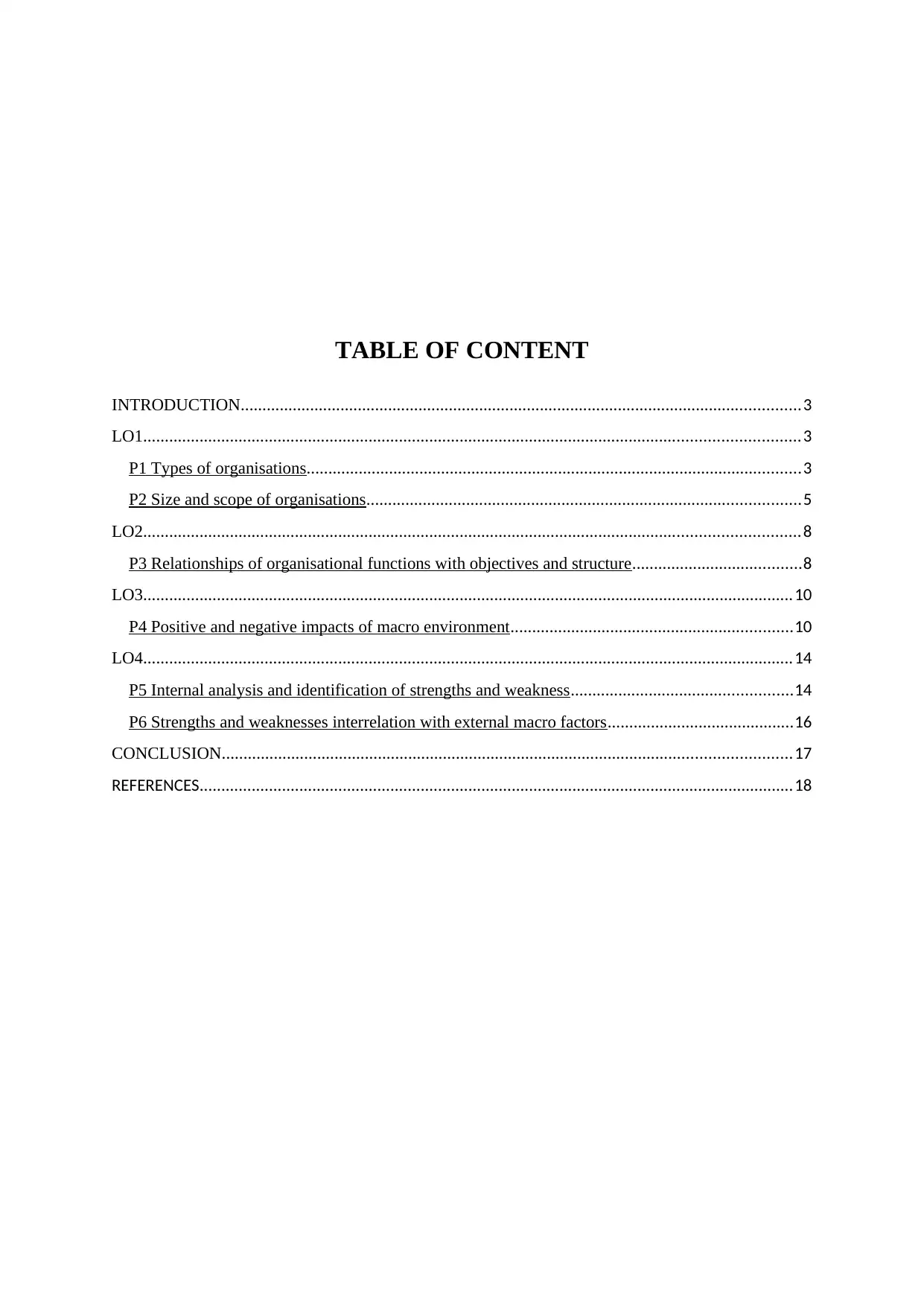
TABLE OF CONTENT
INTRODUCTION.................................................................................................................................3
LO1.......................................................................................................................................................3
P1 Types of organisations..................................................................................................................3
P2 Size and scope of organisations....................................................................................................5
LO2.......................................................................................................................................................8
P3 Relationships of organisational functions with objectives and structure.......................................8
LO3......................................................................................................................................................10
P4 Positive and negative impacts of macro environment.................................................................10
LO4......................................................................................................................................................14
P5 Internal analysis and identification of strengths and weakness...................................................14
P6 Strengths and weaknesses interrelation with external macro factors...........................................16
CONCLUSION...................................................................................................................................17
REFERENCES.........................................................................................................................................18
INTRODUCTION.................................................................................................................................3
LO1.......................................................................................................................................................3
P1 Types of organisations..................................................................................................................3
P2 Size and scope of organisations....................................................................................................5
LO2.......................................................................................................................................................8
P3 Relationships of organisational functions with objectives and structure.......................................8
LO3......................................................................................................................................................10
P4 Positive and negative impacts of macro environment.................................................................10
LO4......................................................................................................................................................14
P5 Internal analysis and identification of strengths and weakness...................................................14
P6 Strengths and weaknesses interrelation with external macro factors...........................................16
CONCLUSION...................................................................................................................................17
REFERENCES.........................................................................................................................................18
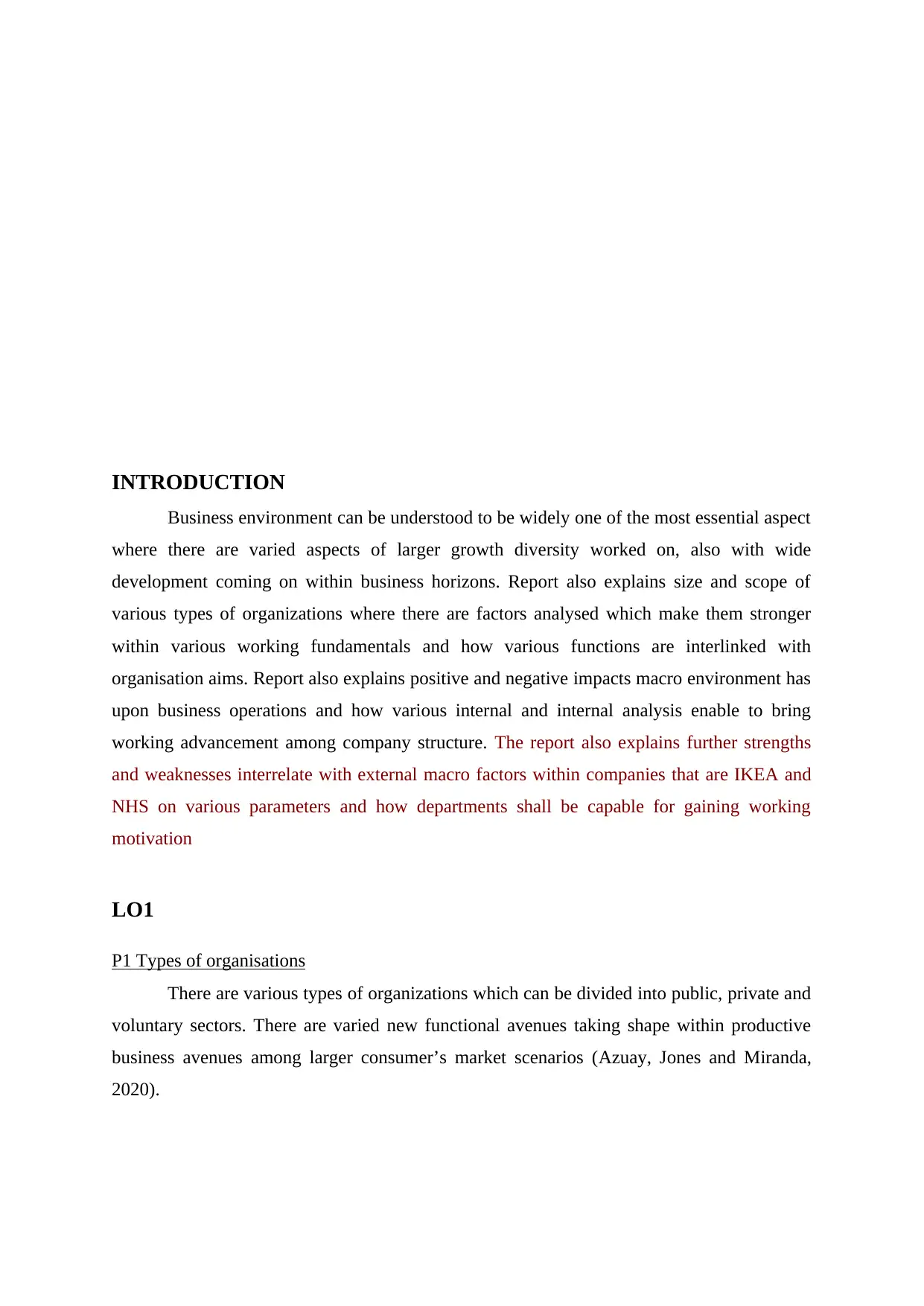
INTRODUCTION
Business environment can be understood to be widely one of the most essential aspect
where there are varied aspects of larger growth diversity worked on, also with wide
development coming on within business horizons. Report also explains size and scope of
various types of organizations where there are factors analysed which make them stronger
within various working fundamentals and how various functions are interlinked with
organisation aims. Report also explains positive and negative impacts macro environment has
upon business operations and how various internal and internal analysis enable to bring
working advancement among company structure. The report also explains further strengths
and weaknesses interrelate with external macro factors within companies that are IKEA and
NHS on various parameters and how departments shall be capable for gaining working
motivation
LO1
P1 Types of organisations
There are various types of organizations which can be divided into public, private and
voluntary sectors. There are varied new functional avenues taking shape within productive
business avenues among larger consumer’s market scenarios (Azuay, Jones and Miranda,
2020).
Business environment can be understood to be widely one of the most essential aspect
where there are varied aspects of larger growth diversity worked on, also with wide
development coming on within business horizons. Report also explains size and scope of
various types of organizations where there are factors analysed which make them stronger
within various working fundamentals and how various functions are interlinked with
organisation aims. Report also explains positive and negative impacts macro environment has
upon business operations and how various internal and internal analysis enable to bring
working advancement among company structure. The report also explains further strengths
and weaknesses interrelate with external macro factors within companies that are IKEA and
NHS on various parameters and how departments shall be capable for gaining working
motivation
LO1
P1 Types of organisations
There are various types of organizations which can be divided into public, private and
voluntary sectors. There are varied new functional avenues taking shape within productive
business avenues among larger consumer’s market scenarios (Azuay, Jones and Miranda,
2020).
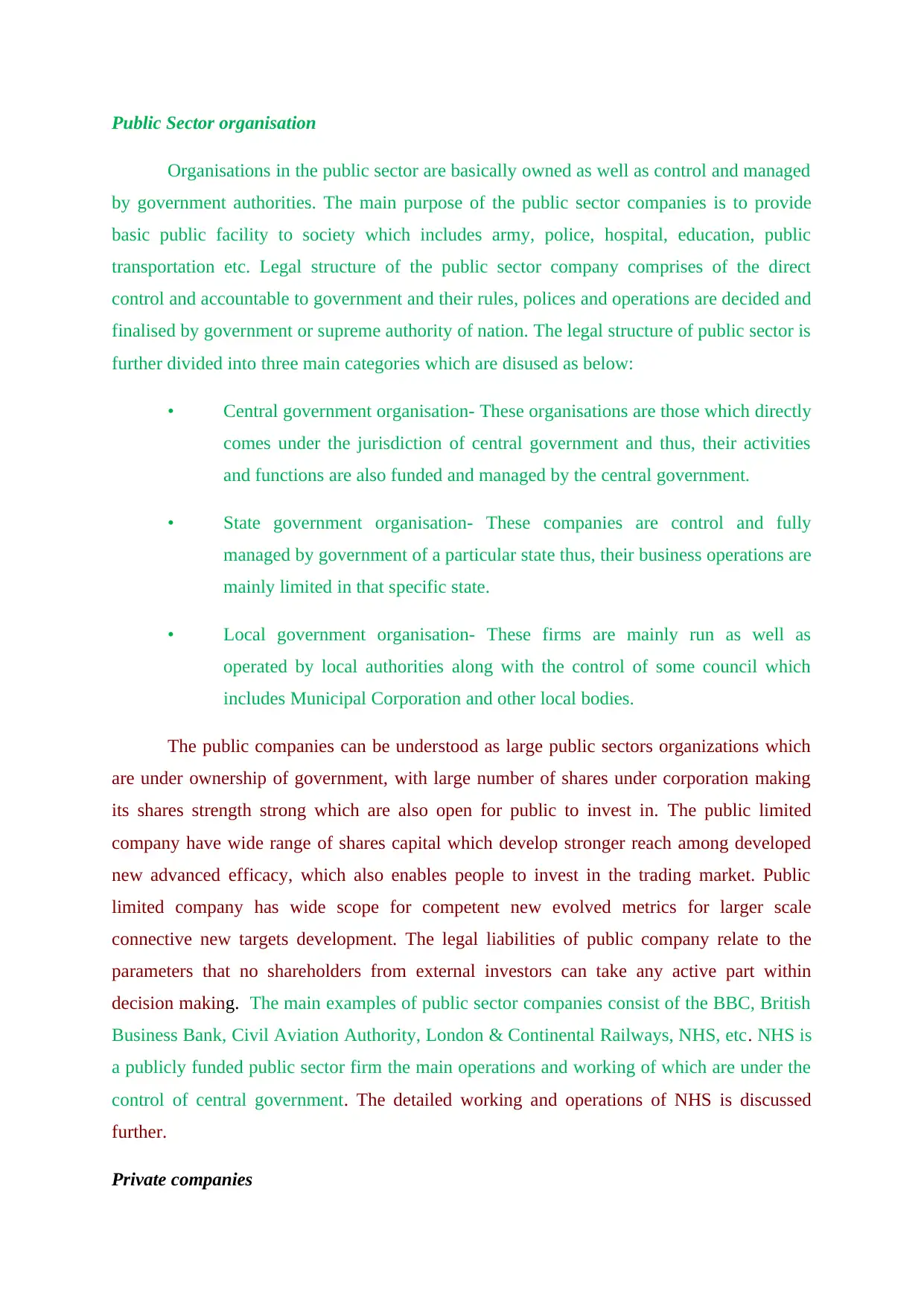
Public Sector organisation
Organisations in the public sector are basically owned as well as control and managed
by government authorities. The main purpose of the public sector companies is to provide
basic public facility to society which includes army, police, hospital, education, public
transportation etc. Legal structure of the public sector company comprises of the direct
control and accountable to government and their rules, polices and operations are decided and
finalised by government or supreme authority of nation. The legal structure of public sector is
further divided into three main categories which are disused as below:
• Central government organisation- These organisations are those which directly
comes under the jurisdiction of central government and thus, their activities
and functions are also funded and managed by the central government.
• State government organisation- These companies are control and fully
managed by government of a particular state thus, their business operations are
mainly limited in that specific state.
• Local government organisation- These firms are mainly run as well as
operated by local authorities along with the control of some council which
includes Municipal Corporation and other local bodies.
The public companies can be understood as large public sectors organizations which
are under ownership of government, with large number of shares under corporation making
its shares strength strong which are also open for public to invest in. The public limited
company have wide range of shares capital which develop stronger reach among developed
new advanced efficacy, which also enables people to invest in the trading market. Public
limited company has wide scope for competent new evolved metrics for larger scale
connective new targets development. The legal liabilities of public company relate to the
parameters that no shareholders from external investors can take any active part within
decision making. The main examples of public sector companies consist of the BBC, British
Business Bank, Civil Aviation Authority, London & Continental Railways, NHS, etc. NHS is
a publicly funded public sector firm the main operations and working of which are under the
control of central government. The detailed working and operations of NHS is discussed
further.
Private companies
Organisations in the public sector are basically owned as well as control and managed
by government authorities. The main purpose of the public sector companies is to provide
basic public facility to society which includes army, police, hospital, education, public
transportation etc. Legal structure of the public sector company comprises of the direct
control and accountable to government and their rules, polices and operations are decided and
finalised by government or supreme authority of nation. The legal structure of public sector is
further divided into three main categories which are disused as below:
• Central government organisation- These organisations are those which directly
comes under the jurisdiction of central government and thus, their activities
and functions are also funded and managed by the central government.
• State government organisation- These companies are control and fully
managed by government of a particular state thus, their business operations are
mainly limited in that specific state.
• Local government organisation- These firms are mainly run as well as
operated by local authorities along with the control of some council which
includes Municipal Corporation and other local bodies.
The public companies can be understood as large public sectors organizations which
are under ownership of government, with large number of shares under corporation making
its shares strength strong which are also open for public to invest in. The public limited
company have wide range of shares capital which develop stronger reach among developed
new advanced efficacy, which also enables people to invest in the trading market. Public
limited company has wide scope for competent new evolved metrics for larger scale
connective new targets development. The legal liabilities of public company relate to the
parameters that no shareholders from external investors can take any active part within
decision making. The main examples of public sector companies consist of the BBC, British
Business Bank, Civil Aviation Authority, London & Continental Railways, NHS, etc. NHS is
a publicly funded public sector firm the main operations and working of which are under the
control of central government. The detailed working and operations of NHS is discussed
further.
Private companies
Secure Best Marks with AI Grader
Need help grading? Try our AI Grader for instant feedback on your assignments.
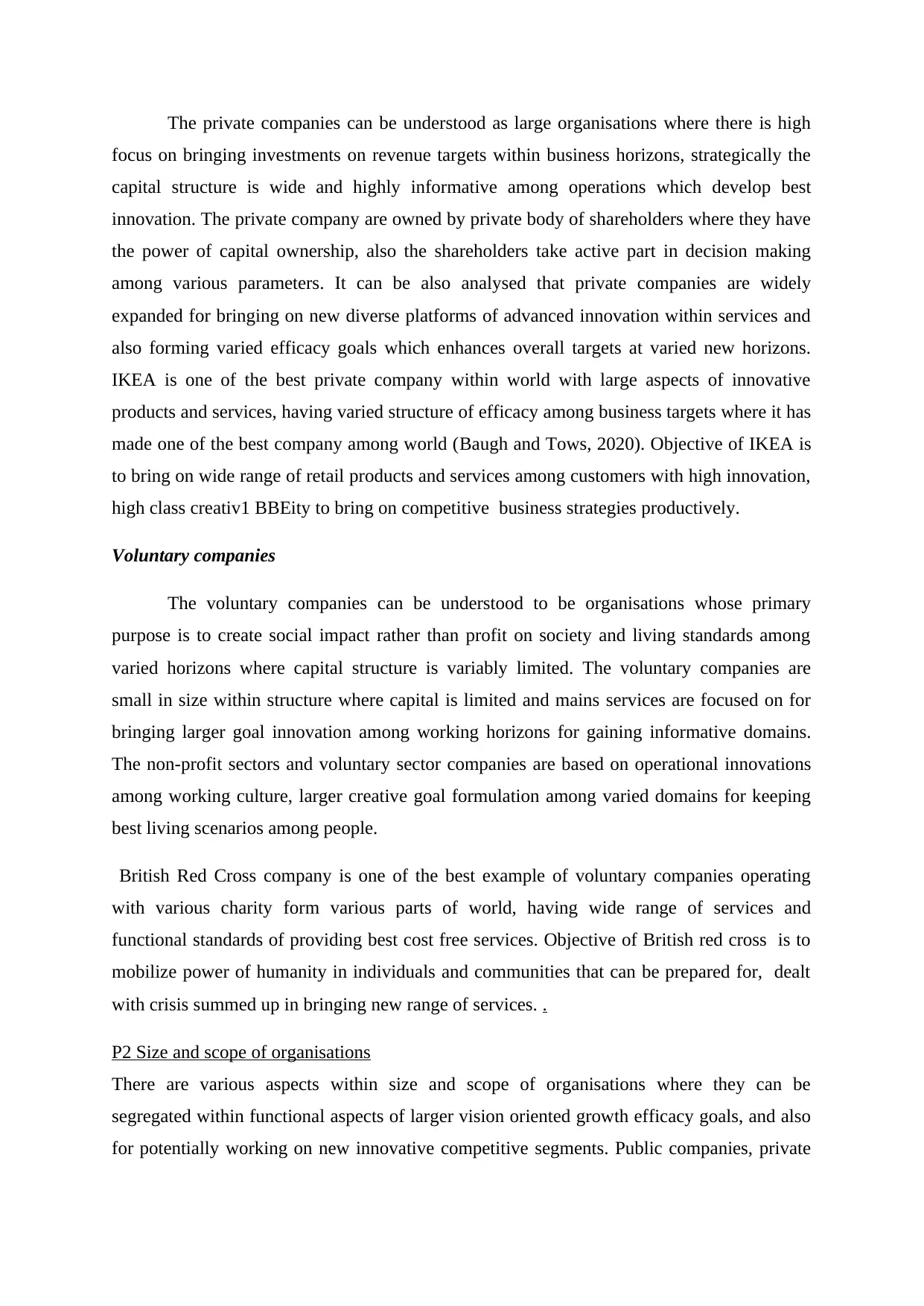
The private companies can be understood as large organisations where there is high
focus on bringing investments on revenue targets within business horizons, strategically the
capital structure is wide and highly informative among operations which develop best
innovation. The private company are owned by private body of shareholders where they have
the power of capital ownership, also the shareholders take active part in decision making
among various parameters. It can be also analysed that private companies are widely
expanded for bringing on new diverse platforms of advanced innovation within services and
also forming varied efficacy goals which enhances overall targets at varied new horizons.
IKEA is one of the best private company within world with large aspects of innovative
products and services, having varied structure of efficacy among business targets where it has
made one of the best company among world (Baugh and Tows, 2020). Objective of IKEA is
to bring on wide range of retail products and services among customers with high innovation,
high class creativ1 BBEity to bring on competitive business strategies productively.
Voluntary companies
The voluntary companies can be understood to be organisations whose primary
purpose is to create social impact rather than profit on society and living standards among
varied horizons where capital structure is variably limited. The voluntary companies are
small in size within structure where capital is limited and mains services are focused on for
bringing larger goal innovation among working horizons for gaining informative domains.
The non-profit sectors and voluntary sector companies are based on operational innovations
among working culture, larger creative goal formulation among varied domains for keeping
best living scenarios among people.
British Red Cross company is one of the best example of voluntary companies operating
with various charity form various parts of world, having wide range of services and
functional standards of providing best cost free services. Objective of British red cross is to
mobilize power of humanity in individuals and communities that can be prepared for, dealt
with crisis summed up in bringing new range of services. .
P2 Size and scope of organisations
There are various aspects within size and scope of organisations where they can be
segregated within functional aspects of larger vision oriented growth efficacy goals, and also
for potentially working on new innovative competitive segments. Public companies, private
focus on bringing investments on revenue targets within business horizons, strategically the
capital structure is wide and highly informative among operations which develop best
innovation. The private company are owned by private body of shareholders where they have
the power of capital ownership, also the shareholders take active part in decision making
among various parameters. It can be also analysed that private companies are widely
expanded for bringing on new diverse platforms of advanced innovation within services and
also forming varied efficacy goals which enhances overall targets at varied new horizons.
IKEA is one of the best private company within world with large aspects of innovative
products and services, having varied structure of efficacy among business targets where it has
made one of the best company among world (Baugh and Tows, 2020). Objective of IKEA is
to bring on wide range of retail products and services among customers with high innovation,
high class creativ1 BBEity to bring on competitive business strategies productively.
Voluntary companies
The voluntary companies can be understood to be organisations whose primary
purpose is to create social impact rather than profit on society and living standards among
varied horizons where capital structure is variably limited. The voluntary companies are
small in size within structure where capital is limited and mains services are focused on for
bringing larger goal innovation among working horizons for gaining informative domains.
The non-profit sectors and voluntary sector companies are based on operational innovations
among working culture, larger creative goal formulation among varied domains for keeping
best living scenarios among people.
British Red Cross company is one of the best example of voluntary companies operating
with various charity form various parts of world, having wide range of services and
functional standards of providing best cost free services. Objective of British red cross is to
mobilize power of humanity in individuals and communities that can be prepared for, dealt
with crisis summed up in bringing new range of services. .
P2 Size and scope of organisations
There are various aspects within size and scope of organisations where they can be
segregated within functional aspects of larger vision oriented growth efficacy goals, and also
for potentially working on new innovative competitive segments. Public companies, private
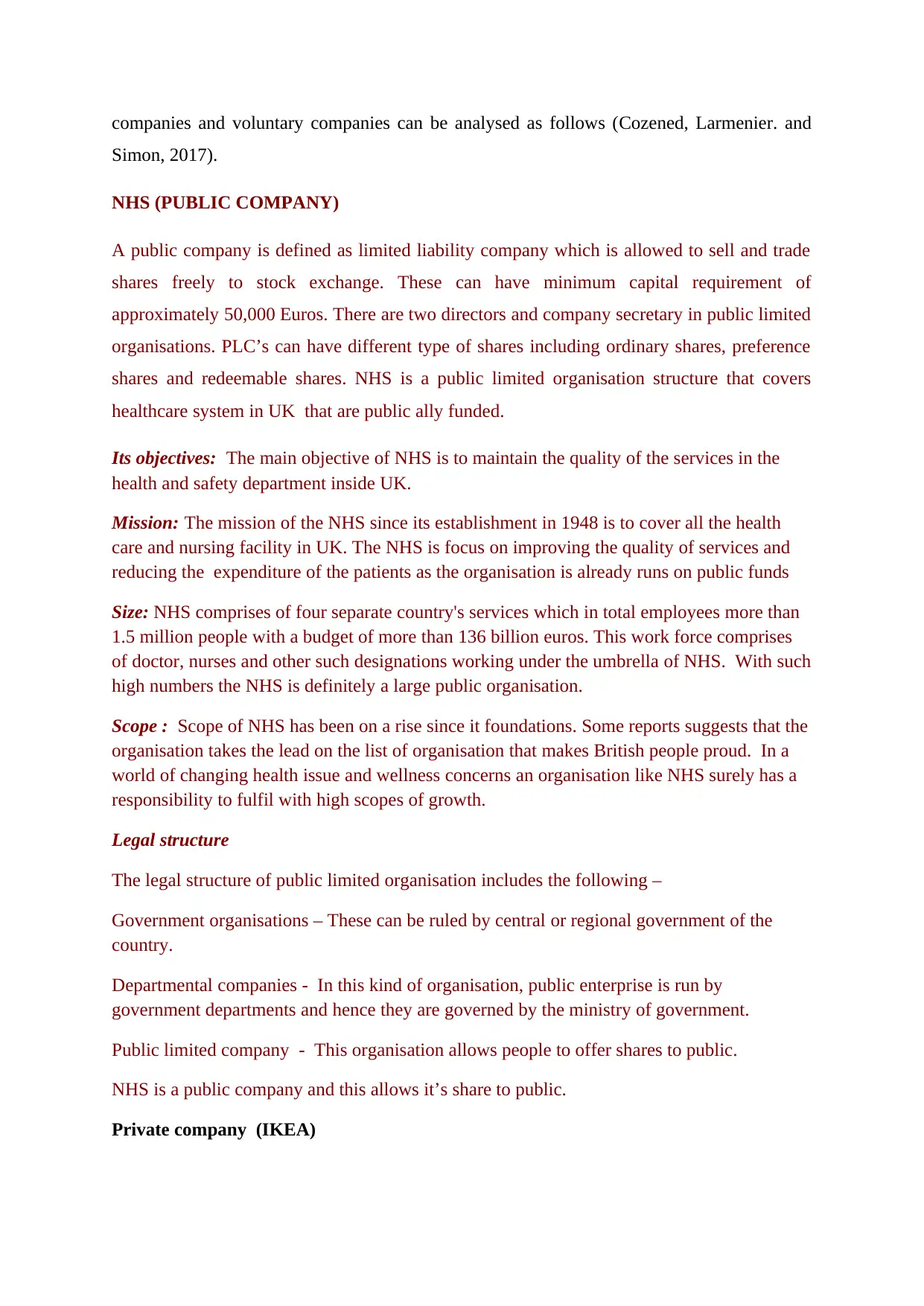
companies and voluntary companies can be analysed as follows (Cozened, Larmenier. and
Simon, 2017).
NHS (PUBLIC COMPANY)
A public company is defined as limited liability company which is allowed to sell and trade
shares freely to stock exchange. These can have minimum capital requirement of
approximately 50,000 Euros. There are two directors and company secretary in public limited
organisations. PLC’s can have different type of shares including ordinary shares, preference
shares and redeemable shares. NHS is a public limited organisation structure that covers
healthcare system in UK that are public ally funded.
Its objectives: The main objective of NHS is to maintain the quality of the services in the
health and safety department inside UK.
Mission: The mission of the NHS since its establishment in 1948 is to cover all the health
care and nursing facility in UK. The NHS is focus on improving the quality of services and
reducing the expenditure of the patients as the organisation is already runs on public funds
Size: NHS comprises of four separate country's services which in total employees more than
1.5 million people with a budget of more than 136 billion euros. This work force comprises
of doctor, nurses and other such designations working under the umbrella of NHS. With such
high numbers the NHS is definitely a large public organisation.
Scope : Scope of NHS has been on a rise since it foundations. Some reports suggests that the
organisation takes the lead on the list of organisation that makes British people proud. In a
world of changing health issue and wellness concerns an organisation like NHS surely has a
responsibility to fulfil with high scopes of growth.
Legal structure
The legal structure of public limited organisation includes the following –
Government organisations – These can be ruled by central or regional government of the
country.
Departmental companies - In this kind of organisation, public enterprise is run by
government departments and hence they are governed by the ministry of government.
Public limited company - This organisation allows people to offer shares to public.
NHS is a public company and this allows it’s share to public.
Private company (IKEA)
Simon, 2017).
NHS (PUBLIC COMPANY)
A public company is defined as limited liability company which is allowed to sell and trade
shares freely to stock exchange. These can have minimum capital requirement of
approximately 50,000 Euros. There are two directors and company secretary in public limited
organisations. PLC’s can have different type of shares including ordinary shares, preference
shares and redeemable shares. NHS is a public limited organisation structure that covers
healthcare system in UK that are public ally funded.
Its objectives: The main objective of NHS is to maintain the quality of the services in the
health and safety department inside UK.
Mission: The mission of the NHS since its establishment in 1948 is to cover all the health
care and nursing facility in UK. The NHS is focus on improving the quality of services and
reducing the expenditure of the patients as the organisation is already runs on public funds
Size: NHS comprises of four separate country's services which in total employees more than
1.5 million people with a budget of more than 136 billion euros. This work force comprises
of doctor, nurses and other such designations working under the umbrella of NHS. With such
high numbers the NHS is definitely a large public organisation.
Scope : Scope of NHS has been on a rise since it foundations. Some reports suggests that the
organisation takes the lead on the list of organisation that makes British people proud. In a
world of changing health issue and wellness concerns an organisation like NHS surely has a
responsibility to fulfil with high scopes of growth.
Legal structure
The legal structure of public limited organisation includes the following –
Government organisations – These can be ruled by central or regional government of the
country.
Departmental companies - In this kind of organisation, public enterprise is run by
government departments and hence they are governed by the ministry of government.
Public limited company - This organisation allows people to offer shares to public.
NHS is a public company and this allows it’s share to public.
Private company (IKEA)
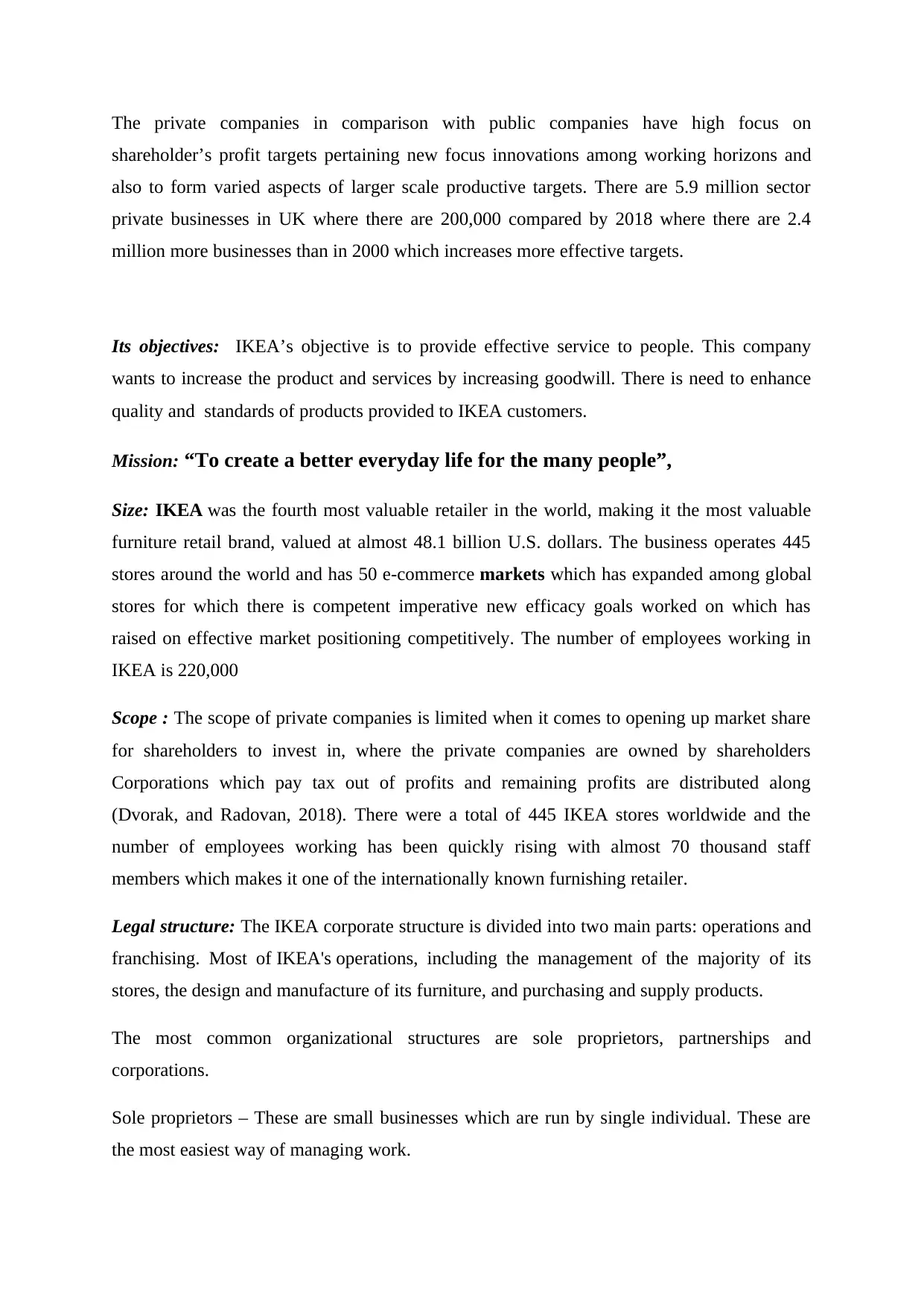
The private companies in comparison with public companies have high focus on
shareholder’s profit targets pertaining new focus innovations among working horizons and
also to form varied aspects of larger scale productive targets. There are 5.9 million sector
private businesses in UK where there are 200,000 compared by 2018 where there are 2.4
million more businesses than in 2000 which increases more effective targets.
Its objectives: IKEA’s objective is to provide effective service to people. This company
wants to increase the product and services by increasing goodwill. There is need to enhance
quality and standards of products provided to IKEA customers.
Mission: “To create a better everyday life for the many people”,
Size: IKEA was the fourth most valuable retailer in the world, making it the most valuable
furniture retail brand, valued at almost 48.1 billion U.S. dollars. The business operates 445
stores around the world and has 50 e-commerce markets which has expanded among global
stores for which there is competent imperative new efficacy goals worked on which has
raised on effective market positioning competitively. The number of employees working in
IKEA is 220,000
Scope : The scope of private companies is limited when it comes to opening up market share
for shareholders to invest in, where the private companies are owned by shareholders
Corporations which pay tax out of profits and remaining profits are distributed along
(Dvorak, and Radovan, 2018). There were a total of 445 IKEA stores worldwide and the
number of employees working has been quickly rising with almost 70 thousand staff
members which makes it one of the internationally known furnishing retailer.
Legal structure: The IKEA corporate structure is divided into two main parts: operations and
franchising. Most of IKEA's operations, including the management of the majority of its
stores, the design and manufacture of its furniture, and purchasing and supply products.
The most common organizational structures are sole proprietors, partnerships and
corporations.
Sole proprietors – These are small businesses which are run by single individual. These are
the most easiest way of managing work.
shareholder’s profit targets pertaining new focus innovations among working horizons and
also to form varied aspects of larger scale productive targets. There are 5.9 million sector
private businesses in UK where there are 200,000 compared by 2018 where there are 2.4
million more businesses than in 2000 which increases more effective targets.
Its objectives: IKEA’s objective is to provide effective service to people. This company
wants to increase the product and services by increasing goodwill. There is need to enhance
quality and standards of products provided to IKEA customers.
Mission: “To create a better everyday life for the many people”,
Size: IKEA was the fourth most valuable retailer in the world, making it the most valuable
furniture retail brand, valued at almost 48.1 billion U.S. dollars. The business operates 445
stores around the world and has 50 e-commerce markets which has expanded among global
stores for which there is competent imperative new efficacy goals worked on which has
raised on effective market positioning competitively. The number of employees working in
IKEA is 220,000
Scope : The scope of private companies is limited when it comes to opening up market share
for shareholders to invest in, where the private companies are owned by shareholders
Corporations which pay tax out of profits and remaining profits are distributed along
(Dvorak, and Radovan, 2018). There were a total of 445 IKEA stores worldwide and the
number of employees working has been quickly rising with almost 70 thousand staff
members which makes it one of the internationally known furnishing retailer.
Legal structure: The IKEA corporate structure is divided into two main parts: operations and
franchising. Most of IKEA's operations, including the management of the majority of its
stores, the design and manufacture of its furniture, and purchasing and supply products.
The most common organizational structures are sole proprietors, partnerships and
corporations.
Sole proprietors – These are small businesses which are run by single individual. These are
the most easiest way of managing work.
Paraphrase This Document
Need a fresh take? Get an instant paraphrase of this document with our AI Paraphraser
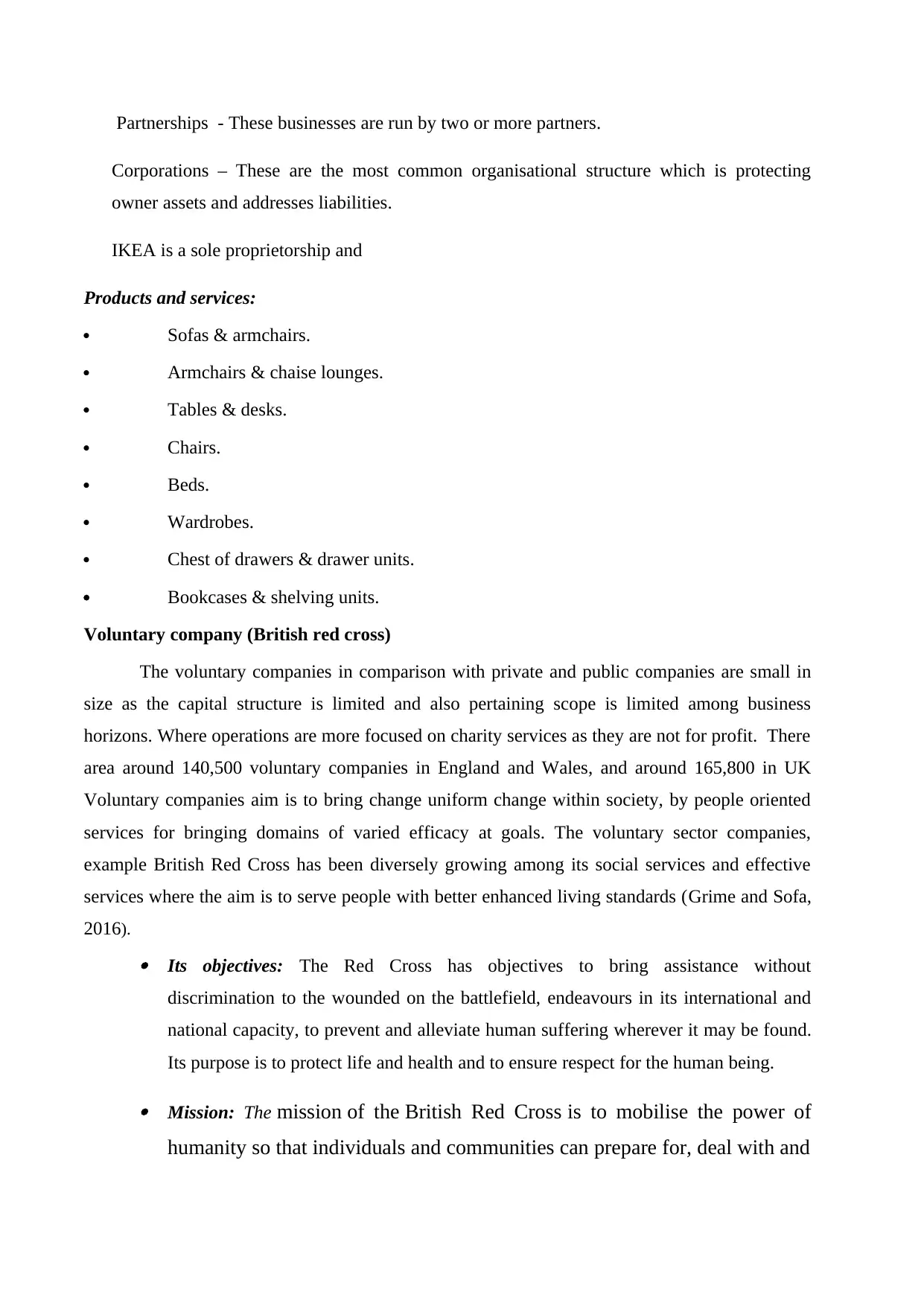
Partnerships - These businesses are run by two or more partners.
Corporations – These are the most common organisational structure which is protecting
owner assets and addresses liabilities.
IKEA is a sole proprietorship and
Products and services:
Sofas & armchairs.
Armchairs & chaise lounges.
Tables & desks.
Chairs.
Beds.
Wardrobes.
Chest of drawers & drawer units.
Bookcases & shelving units.
Voluntary company (British red cross)
The voluntary companies in comparison with private and public companies are small in
size as the capital structure is limited and also pertaining scope is limited among business
horizons. Where operations are more focused on charity services as they are not for profit. There
area around 140,500 voluntary companies in England and Wales, and around 165,800 in UK
Voluntary companies aim is to bring change uniform change within society, by people oriented
services for bringing domains of varied efficacy at goals. The voluntary sector companies,
example British Red Cross has been diversely growing among its social services and effective
services where the aim is to serve people with better enhanced living standards (Grime and Sofa,
2016). Its objectives: The Red Cross has objectives to bring assistance without
discrimination to the wounded on the battlefield, endeavours in its international and
national capacity, to prevent and alleviate human suffering wherever it may be found.
Its purpose is to protect life and health and to ensure respect for the human being.
Mission: The mission of the British Red Cross is to mobilise the power of
humanity so that individuals and communities can prepare for, deal with and
Corporations – These are the most common organisational structure which is protecting
owner assets and addresses liabilities.
IKEA is a sole proprietorship and
Products and services:
Sofas & armchairs.
Armchairs & chaise lounges.
Tables & desks.
Chairs.
Beds.
Wardrobes.
Chest of drawers & drawer units.
Bookcases & shelving units.
Voluntary company (British red cross)
The voluntary companies in comparison with private and public companies are small in
size as the capital structure is limited and also pertaining scope is limited among business
horizons. Where operations are more focused on charity services as they are not for profit. There
area around 140,500 voluntary companies in England and Wales, and around 165,800 in UK
Voluntary companies aim is to bring change uniform change within society, by people oriented
services for bringing domains of varied efficacy at goals. The voluntary sector companies,
example British Red Cross has been diversely growing among its social services and effective
services where the aim is to serve people with better enhanced living standards (Grime and Sofa,
2016). Its objectives: The Red Cross has objectives to bring assistance without
discrimination to the wounded on the battlefield, endeavours in its international and
national capacity, to prevent and alleviate human suffering wherever it may be found.
Its purpose is to protect life and health and to ensure respect for the human being.
Mission: The mission of the British Red Cross is to mobilise the power of
humanity so that individuals and communities can prepare for, deal with and
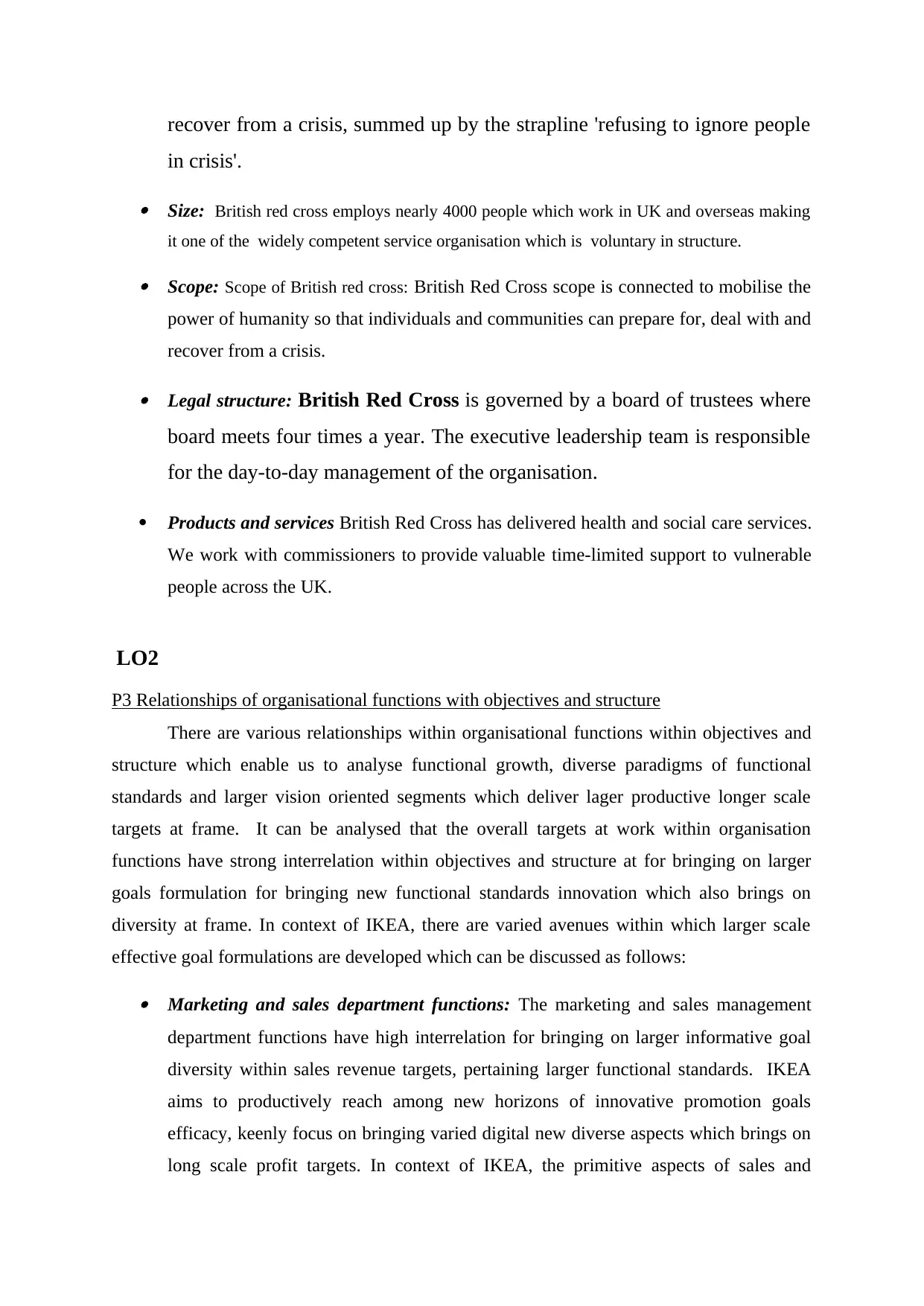
recover from a crisis, summed up by the strapline 'refusing to ignore people
in crisis'.
Size: British red cross employs nearly 4000 people which work in UK and overseas making
it one of the widely competent service organisation which is voluntary in structure.
Scope: Scope of British red cross: British Red Cross scope is connected to mobilise the
power of humanity so that individuals and communities can prepare for, deal with and
recover from a crisis.
Legal structure: British Red Cross is governed by a board of trustees where
board meets four times a year. The executive leadership team is responsible
for the day-to-day management of the organisation.
Products and services British Red Cross has delivered health and social care services.
We work with commissioners to provide valuable time-limited support to vulnerable
people across the UK.
LO2
P3 Relationships of organisational functions with objectives and structure
There are various relationships within organisational functions within objectives and
structure which enable us to analyse functional growth, diverse paradigms of functional
standards and larger vision oriented segments which deliver lager productive longer scale
targets at frame. It can be analysed that the overall targets at work within organisation
functions have strong interrelation within objectives and structure at for bringing on larger
goals formulation for bringing new functional standards innovation which also brings on
diversity at frame. In context of IKEA, there are varied avenues within which larger scale
effective goal formulations are developed which can be discussed as follows:
Marketing and sales department functions: The marketing and sales management
department functions have high interrelation for bringing on larger informative goal
diversity within sales revenue targets, pertaining larger functional standards. IKEA
aims to productively reach among new horizons of innovative promotion goals
efficacy, keenly focus on bringing varied digital new diverse aspects which brings on
long scale profit targets. In context of IKEA, the primitive aspects of sales and
in crisis'.
Size: British red cross employs nearly 4000 people which work in UK and overseas making
it one of the widely competent service organisation which is voluntary in structure.
Scope: Scope of British red cross: British Red Cross scope is connected to mobilise the
power of humanity so that individuals and communities can prepare for, deal with and
recover from a crisis.
Legal structure: British Red Cross is governed by a board of trustees where
board meets four times a year. The executive leadership team is responsible
for the day-to-day management of the organisation.
Products and services British Red Cross has delivered health and social care services.
We work with commissioners to provide valuable time-limited support to vulnerable
people across the UK.
LO2
P3 Relationships of organisational functions with objectives and structure
There are various relationships within organisational functions within objectives and
structure which enable us to analyse functional growth, diverse paradigms of functional
standards and larger vision oriented segments which deliver lager productive longer scale
targets at frame. It can be analysed that the overall targets at work within organisation
functions have strong interrelation within objectives and structure at for bringing on larger
goals formulation for bringing new functional standards innovation which also brings on
diversity at frame. In context of IKEA, there are varied avenues within which larger scale
effective goal formulations are developed which can be discussed as follows:
Marketing and sales department functions: The marketing and sales management
department functions have high interrelation for bringing on larger informative goal
diversity within sales revenue targets, pertaining larger functional standards. IKEA
aims to productively reach among new horizons of innovative promotion goals
efficacy, keenly focus on bringing varied digital new diverse aspects which brings on
long scale profit targets. In context of IKEA, the primitive aspects of sales and
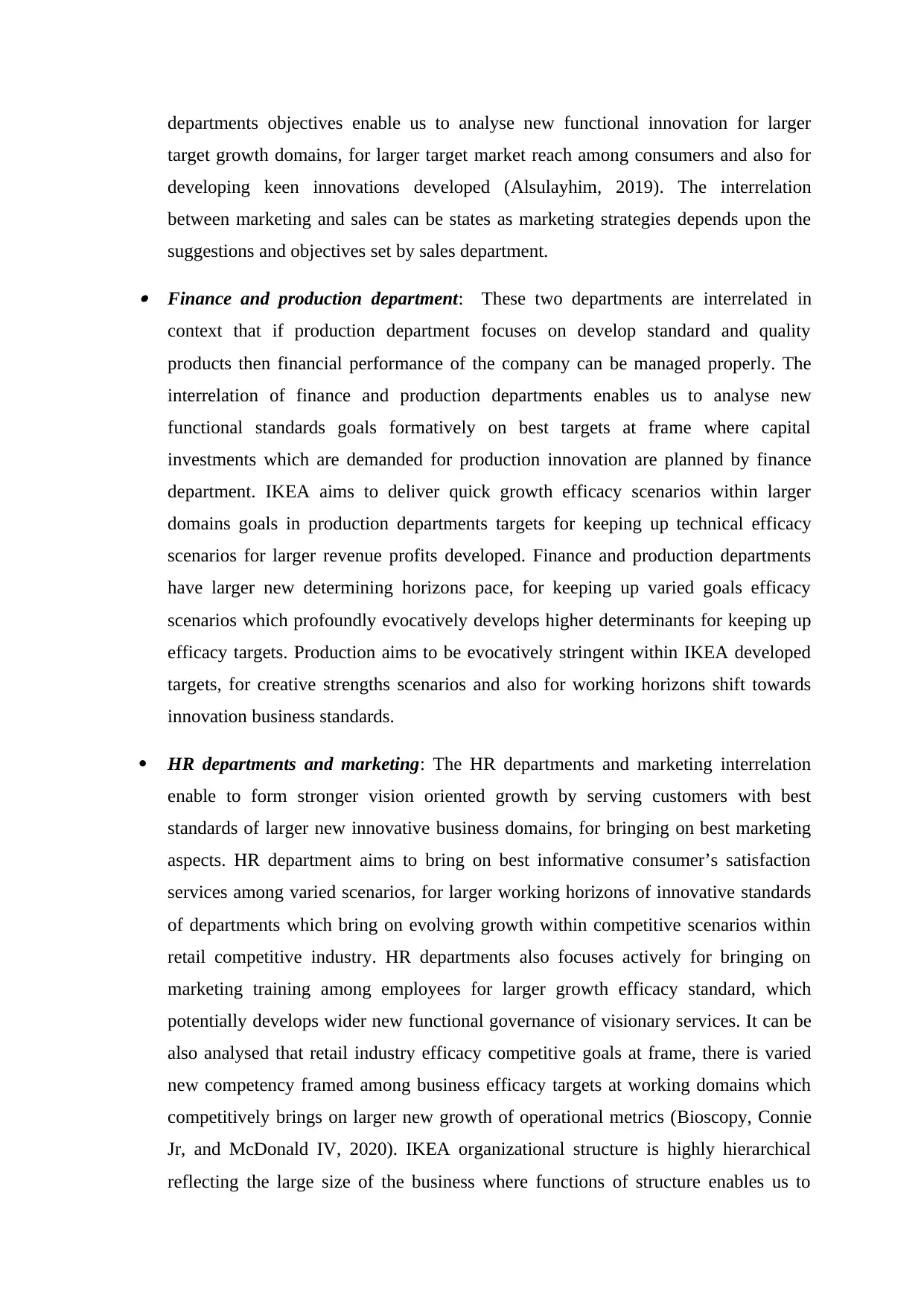
departments objectives enable us to analyse new functional innovation for larger
target growth domains, for larger target market reach among consumers and also for
developing keen innovations developed (Alsulayhim, 2019). The interrelation
between marketing and sales can be states as marketing strategies depends upon the
suggestions and objectives set by sales department.
Finance and production department: These two departments are interrelated in
context that if production department focuses on develop standard and quality
products then financial performance of the company can be managed properly. The
interrelation of finance and production departments enables us to analyse new
functional standards goals formatively on best targets at frame where capital
investments which are demanded for production innovation are planned by finance
department. IKEA aims to deliver quick growth efficacy scenarios within larger
domains goals in production departments targets for keeping up technical efficacy
scenarios for larger revenue profits developed. Finance and production departments
have larger new determining horizons pace, for keeping up varied goals efficacy
scenarios which profoundly evocatively develops higher determinants for keeping up
efficacy targets. Production aims to be evocatively stringent within IKEA developed
targets, for creative strengths scenarios and also for working horizons shift towards
innovation business standards.
HR departments and marketing: The HR departments and marketing interrelation
enable to form stronger vision oriented growth by serving customers with best
standards of larger new innovative business domains, for bringing on best marketing
aspects. HR department aims to bring on best informative consumer’s satisfaction
services among varied scenarios, for larger working horizons of innovative standards
of departments which bring on evolving growth within competitive scenarios within
retail competitive industry. HR departments also focuses actively for bringing on
marketing training among employees for larger growth efficacy standard, which
potentially develops wider new functional governance of visionary services. It can be
also analysed that retail industry efficacy competitive goals at frame, there is varied
new competency framed among business efficacy targets at working domains which
competitively brings on larger new growth of operational metrics (Bioscopy, Connie
Jr, and McDonald IV, 2020). IKEA organizational structure is highly hierarchical
reflecting the large size of the business where functions of structure enables us to
target growth domains, for larger target market reach among consumers and also for
developing keen innovations developed (Alsulayhim, 2019). The interrelation
between marketing and sales can be states as marketing strategies depends upon the
suggestions and objectives set by sales department.
Finance and production department: These two departments are interrelated in
context that if production department focuses on develop standard and quality
products then financial performance of the company can be managed properly. The
interrelation of finance and production departments enables us to analyse new
functional standards goals formatively on best targets at frame where capital
investments which are demanded for production innovation are planned by finance
department. IKEA aims to deliver quick growth efficacy scenarios within larger
domains goals in production departments targets for keeping up technical efficacy
scenarios for larger revenue profits developed. Finance and production departments
have larger new determining horizons pace, for keeping up varied goals efficacy
scenarios which profoundly evocatively develops higher determinants for keeping up
efficacy targets. Production aims to be evocatively stringent within IKEA developed
targets, for creative strengths scenarios and also for working horizons shift towards
innovation business standards.
HR departments and marketing: The HR departments and marketing interrelation
enable to form stronger vision oriented growth by serving customers with best
standards of larger new innovative business domains, for bringing on best marketing
aspects. HR department aims to bring on best informative consumer’s satisfaction
services among varied scenarios, for larger working horizons of innovative standards
of departments which bring on evolving growth within competitive scenarios within
retail competitive industry. HR departments also focuses actively for bringing on
marketing training among employees for larger growth efficacy standard, which
potentially develops wider new functional governance of visionary services. It can be
also analysed that retail industry efficacy competitive goals at frame, there is varied
new competency framed among business efficacy targets at working domains which
competitively brings on larger new growth of operational metrics (Bioscopy, Connie
Jr, and McDonald IV, 2020). IKEA organizational structure is highly hierarchical
reflecting the large size of the business where functions of structure enables us to
Secure Best Marks with AI Grader
Need help grading? Try our AI Grader for instant feedback on your assignments.
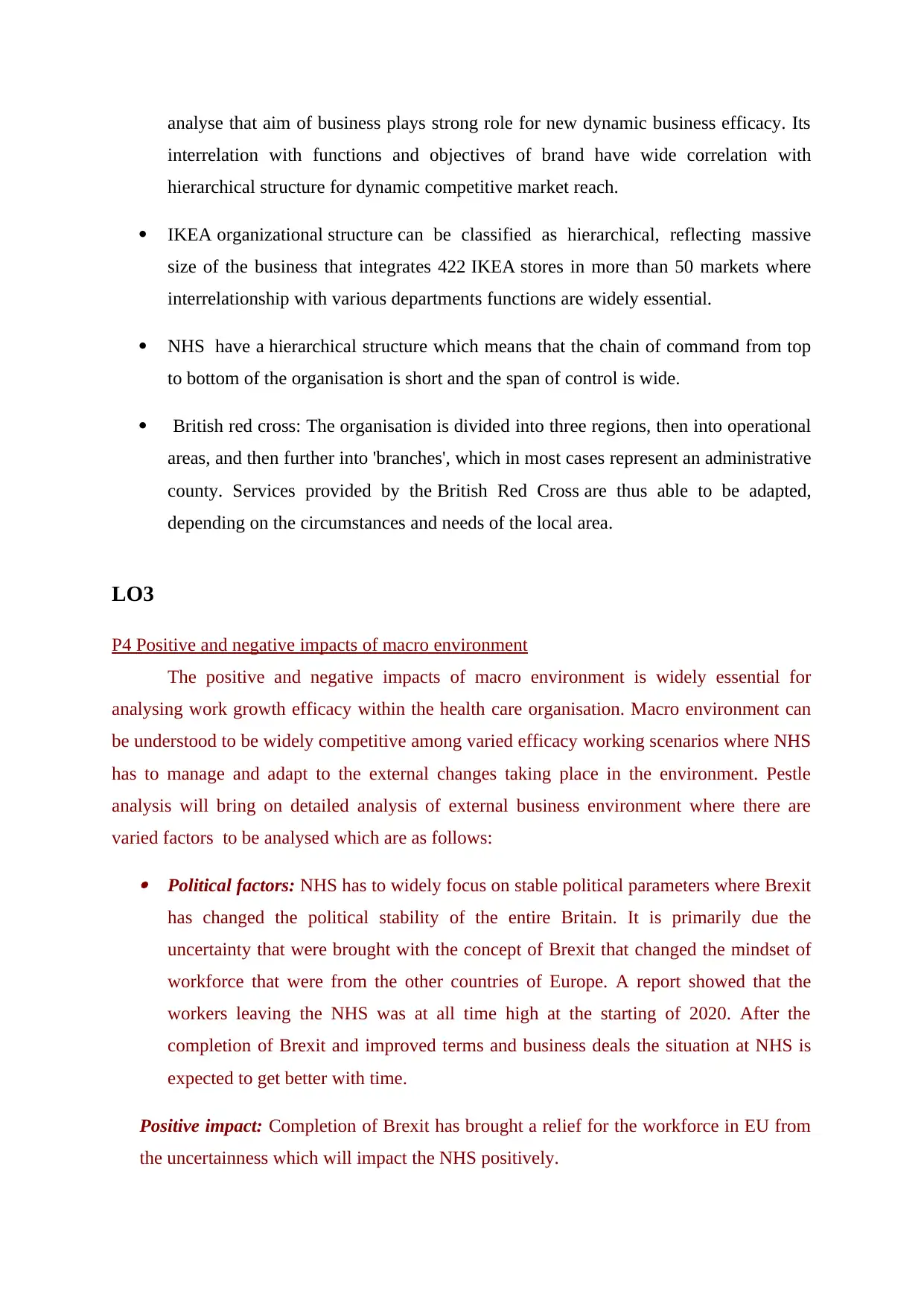
analyse that aim of business plays strong role for new dynamic business efficacy. Its
interrelation with functions and objectives of brand have wide correlation with
hierarchical structure for dynamic competitive market reach.
IKEA organizational structure can be classified as hierarchical, reflecting massive
size of the business that integrates 422 IKEA stores in more than 50 markets where
interrelationship with various departments functions are widely essential.
NHS have a hierarchical structure which means that the chain of command from top
to bottom of the organisation is short and the span of control is wide.
British red cross: The organisation is divided into three regions, then into operational
areas, and then further into 'branches', which in most cases represent an administrative
county. Services provided by the British Red Cross are thus able to be adapted,
depending on the circumstances and needs of the local area.
LO3
P4 Positive and negative impacts of macro environment
The positive and negative impacts of macro environment is widely essential for
analysing work growth efficacy within the health care organisation. Macro environment can
be understood to be widely competitive among varied efficacy working scenarios where NHS
has to manage and adapt to the external changes taking place in the environment. Pestle
analysis will bring on detailed analysis of external business environment where there are
varied factors to be analysed which are as follows:
Political factors: NHS has to widely focus on stable political parameters where Brexit
has changed the political stability of the entire Britain. It is primarily due the
uncertainty that were brought with the concept of Brexit that changed the mindset of
workforce that were from the other countries of Europe. A report showed that the
workers leaving the NHS was at all time high at the starting of 2020. After the
completion of Brexit and improved terms and business deals the situation at NHS is
expected to get better with time.
Positive impact: Completion of Brexit has brought a relief for the workforce in EU from
the uncertainness which will impact the NHS positively.
interrelation with functions and objectives of brand have wide correlation with
hierarchical structure for dynamic competitive market reach.
IKEA organizational structure can be classified as hierarchical, reflecting massive
size of the business that integrates 422 IKEA stores in more than 50 markets where
interrelationship with various departments functions are widely essential.
NHS have a hierarchical structure which means that the chain of command from top
to bottom of the organisation is short and the span of control is wide.
British red cross: The organisation is divided into three regions, then into operational
areas, and then further into 'branches', which in most cases represent an administrative
county. Services provided by the British Red Cross are thus able to be adapted,
depending on the circumstances and needs of the local area.
LO3
P4 Positive and negative impacts of macro environment
The positive and negative impacts of macro environment is widely essential for
analysing work growth efficacy within the health care organisation. Macro environment can
be understood to be widely competitive among varied efficacy working scenarios where NHS
has to manage and adapt to the external changes taking place in the environment. Pestle
analysis will bring on detailed analysis of external business environment where there are
varied factors to be analysed which are as follows:
Political factors: NHS has to widely focus on stable political parameters where Brexit
has changed the political stability of the entire Britain. It is primarily due the
uncertainty that were brought with the concept of Brexit that changed the mindset of
workforce that were from the other countries of Europe. A report showed that the
workers leaving the NHS was at all time high at the starting of 2020. After the
completion of Brexit and improved terms and business deals the situation at NHS is
expected to get better with time.
Positive impact: Completion of Brexit has brought a relief for the workforce in EU from
the uncertainness which will impact the NHS positively.
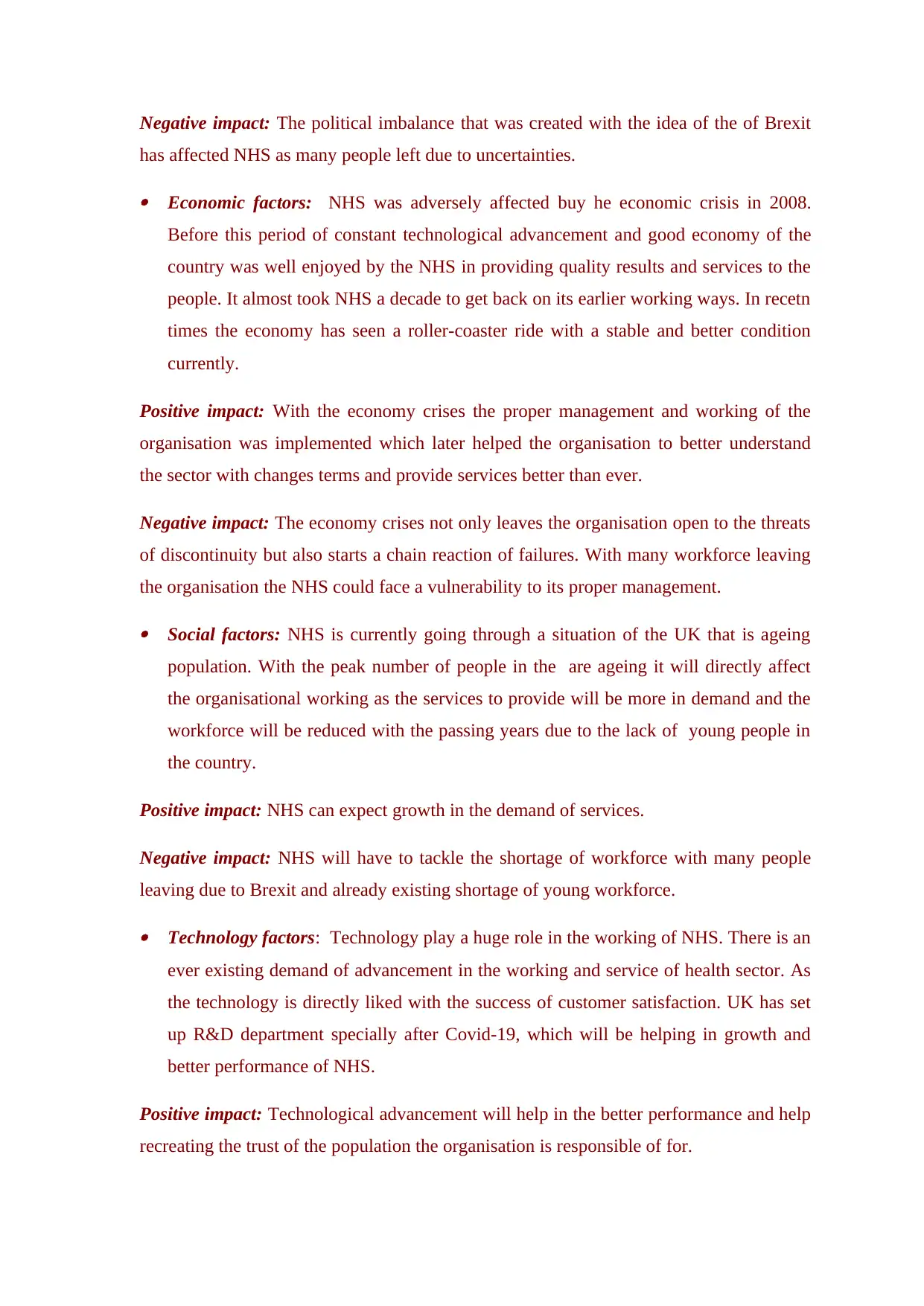
Negative impact: The political imbalance that was created with the idea of the of Brexit
has affected NHS as many people left due to uncertainties.
Economic factors: NHS was adversely affected buy he economic crisis in 2008.
Before this period of constant technological advancement and good economy of the
country was well enjoyed by the NHS in providing quality results and services to the
people. It almost took NHS a decade to get back on its earlier working ways. In recetn
times the economy has seen a roller-coaster ride with a stable and better condition
currently.
Positive impact: With the economy crises the proper management and working of the
organisation was implemented which later helped the organisation to better understand
the sector with changes terms and provide services better than ever.
Negative impact: The economy crises not only leaves the organisation open to the threats
of discontinuity but also starts a chain reaction of failures. With many workforce leaving
the organisation the NHS could face a vulnerability to its proper management.
Social factors: NHS is currently going through a situation of the UK that is ageing
population. With the peak number of people in the are ageing it will directly affect
the organisational working as the services to provide will be more in demand and the
workforce will be reduced with the passing years due to the lack of young people in
the country.
Positive impact: NHS can expect growth in the demand of services.
Negative impact: NHS will have to tackle the shortage of workforce with many people
leaving due to Brexit and already existing shortage of young workforce.
Technology factors: Technology play a huge role in the working of NHS. There is an
ever existing demand of advancement in the working and service of health sector. As
the technology is directly liked with the success of customer satisfaction. UK has set
up R&D department specially after Covid-19, which will be helping in growth and
better performance of NHS.
Positive impact: Technological advancement will help in the better performance and help
recreating the trust of the population the organisation is responsible of for.
has affected NHS as many people left due to uncertainties.
Economic factors: NHS was adversely affected buy he economic crisis in 2008.
Before this period of constant technological advancement and good economy of the
country was well enjoyed by the NHS in providing quality results and services to the
people. It almost took NHS a decade to get back on its earlier working ways. In recetn
times the economy has seen a roller-coaster ride with a stable and better condition
currently.
Positive impact: With the economy crises the proper management and working of the
organisation was implemented which later helped the organisation to better understand
the sector with changes terms and provide services better than ever.
Negative impact: The economy crises not only leaves the organisation open to the threats
of discontinuity but also starts a chain reaction of failures. With many workforce leaving
the organisation the NHS could face a vulnerability to its proper management.
Social factors: NHS is currently going through a situation of the UK that is ageing
population. With the peak number of people in the are ageing it will directly affect
the organisational working as the services to provide will be more in demand and the
workforce will be reduced with the passing years due to the lack of young people in
the country.
Positive impact: NHS can expect growth in the demand of services.
Negative impact: NHS will have to tackle the shortage of workforce with many people
leaving due to Brexit and already existing shortage of young workforce.
Technology factors: Technology play a huge role in the working of NHS. There is an
ever existing demand of advancement in the working and service of health sector. As
the technology is directly liked with the success of customer satisfaction. UK has set
up R&D department specially after Covid-19, which will be helping in growth and
better performance of NHS.
Positive impact: Technological advancement will help in the better performance and help
recreating the trust of the population the organisation is responsible of for.
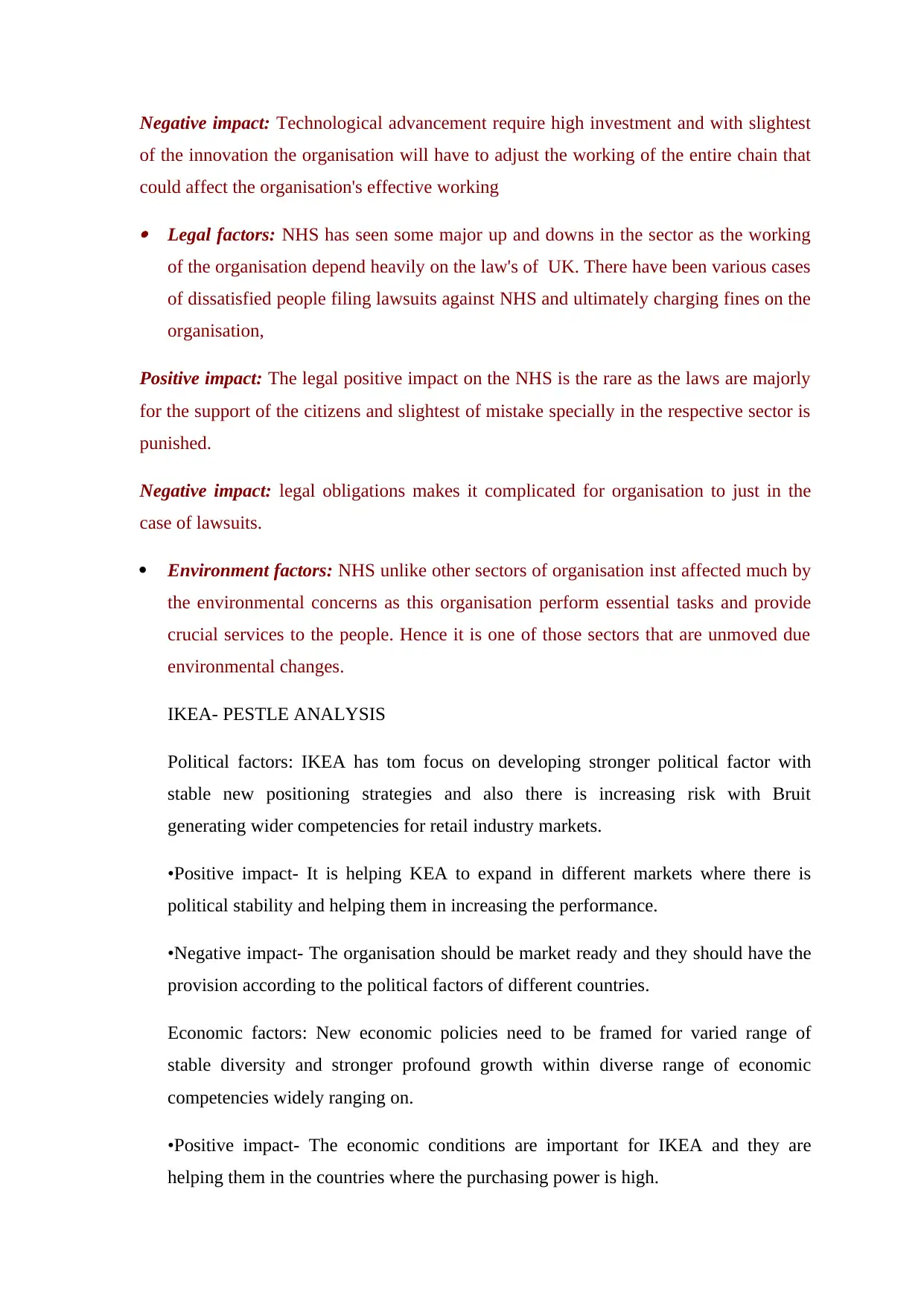
Negative impact: Technological advancement require high investment and with slightest
of the innovation the organisation will have to adjust the working of the entire chain that
could affect the organisation's effective working
Legal factors: NHS has seen some major up and downs in the sector as the working
of the organisation depend heavily on the law's of UK. There have been various cases
of dissatisfied people filing lawsuits against NHS and ultimately charging fines on the
organisation,
Positive impact: The legal positive impact on the NHS is the rare as the laws are majorly
for the support of the citizens and slightest of mistake specially in the respective sector is
punished.
Negative impact: legal obligations makes it complicated for organisation to just in the
case of lawsuits.
Environment factors: NHS unlike other sectors of organisation inst affected much by
the environmental concerns as this organisation perform essential tasks and provide
crucial services to the people. Hence it is one of those sectors that are unmoved due
environmental changes.
IKEA- PESTLE ANALYSIS
Political factors: IKEA has tom focus on developing stronger political factor with
stable new positioning strategies and also there is increasing risk with Bruit
generating wider competencies for retail industry markets.
•Positive impact- It is helping KEA to expand in different markets where there is
political stability and helping them in increasing the performance.
•Negative impact- The organisation should be market ready and they should have the
provision according to the political factors of different countries.
Economic factors: New economic policies need to be framed for varied range of
stable diversity and stronger profound growth within diverse range of economic
competencies widely ranging on.
•Positive impact- The economic conditions are important for IKEA and they are
helping them in the countries where the purchasing power is high.
of the innovation the organisation will have to adjust the working of the entire chain that
could affect the organisation's effective working
Legal factors: NHS has seen some major up and downs in the sector as the working
of the organisation depend heavily on the law's of UK. There have been various cases
of dissatisfied people filing lawsuits against NHS and ultimately charging fines on the
organisation,
Positive impact: The legal positive impact on the NHS is the rare as the laws are majorly
for the support of the citizens and slightest of mistake specially in the respective sector is
punished.
Negative impact: legal obligations makes it complicated for organisation to just in the
case of lawsuits.
Environment factors: NHS unlike other sectors of organisation inst affected much by
the environmental concerns as this organisation perform essential tasks and provide
crucial services to the people. Hence it is one of those sectors that are unmoved due
environmental changes.
IKEA- PESTLE ANALYSIS
Political factors: IKEA has tom focus on developing stronger political factor with
stable new positioning strategies and also there is increasing risk with Bruit
generating wider competencies for retail industry markets.
•Positive impact- It is helping KEA to expand in different markets where there is
political stability and helping them in increasing the performance.
•Negative impact- The organisation should be market ready and they should have the
provision according to the political factors of different countries.
Economic factors: New economic policies need to be framed for varied range of
stable diversity and stronger profound growth within diverse range of economic
competencies widely ranging on.
•Positive impact- The economic conditions are important for IKEA and they are
helping them in the countries where the purchasing power is high.
Paraphrase This Document
Need a fresh take? Get an instant paraphrase of this document with our AI Paraphraser
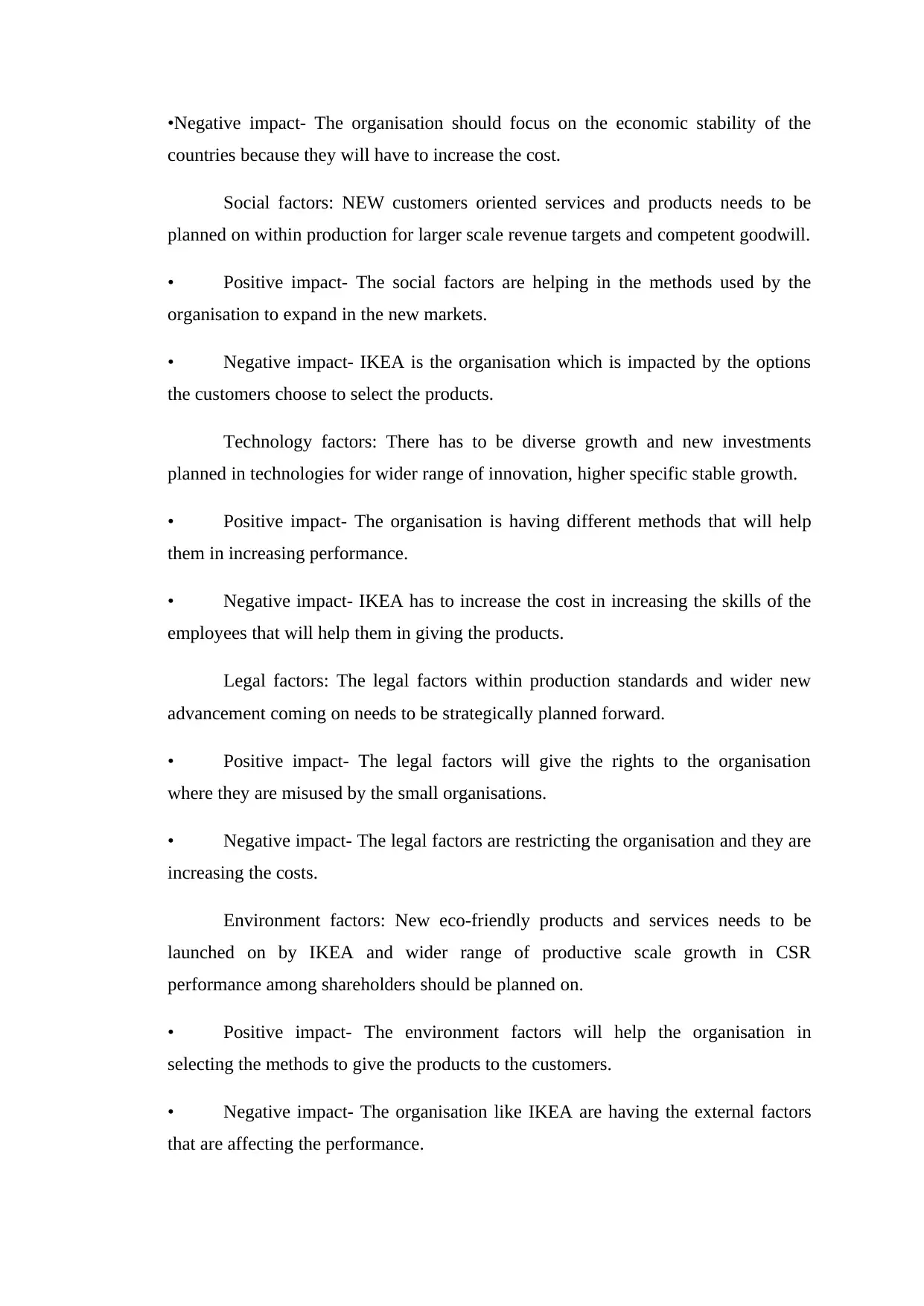
•Negative impact- The organisation should focus on the economic stability of the
countries because they will have to increase the cost.
Social factors: NEW customers oriented services and products needs to be
planned on within production for larger scale revenue targets and competent goodwill.
• Positive impact- The social factors are helping in the methods used by the
organisation to expand in the new markets.
• Negative impact- IKEA is the organisation which is impacted by the options
the customers choose to select the products.
Technology factors: There has to be diverse growth and new investments
planned in technologies for wider range of innovation, higher specific stable growth.
• Positive impact- The organisation is having different methods that will help
them in increasing performance.
• Negative impact- IKEA has to increase the cost in increasing the skills of the
employees that will help them in giving the products.
Legal factors: The legal factors within production standards and wider new
advancement coming on needs to be strategically planned forward.
• Positive impact- The legal factors will give the rights to the organisation
where they are misused by the small organisations.
• Negative impact- The legal factors are restricting the organisation and they are
increasing the costs.
Environment factors: New eco-friendly products and services needs to be
launched on by IKEA and wider range of productive scale growth in CSR
performance among shareholders should be planned on.
• Positive impact- The environment factors will help the organisation in
selecting the methods to give the products to the customers.
• Negative impact- The organisation like IKEA are having the external factors
that are affecting the performance.
countries because they will have to increase the cost.
Social factors: NEW customers oriented services and products needs to be
planned on within production for larger scale revenue targets and competent goodwill.
• Positive impact- The social factors are helping in the methods used by the
organisation to expand in the new markets.
• Negative impact- IKEA is the organisation which is impacted by the options
the customers choose to select the products.
Technology factors: There has to be diverse growth and new investments
planned in technologies for wider range of innovation, higher specific stable growth.
• Positive impact- The organisation is having different methods that will help
them in increasing performance.
• Negative impact- IKEA has to increase the cost in increasing the skills of the
employees that will help them in giving the products.
Legal factors: The legal factors within production standards and wider new
advancement coming on needs to be strategically planned forward.
• Positive impact- The legal factors will give the rights to the organisation
where they are misused by the small organisations.
• Negative impact- The legal factors are restricting the organisation and they are
increasing the costs.
Environment factors: New eco-friendly products and services needs to be
launched on by IKEA and wider range of productive scale growth in CSR
performance among shareholders should be planned on.
• Positive impact- The environment factors will help the organisation in
selecting the methods to give the products to the customers.
• Negative impact- The organisation like IKEA are having the external factors
that are affecting the performance.
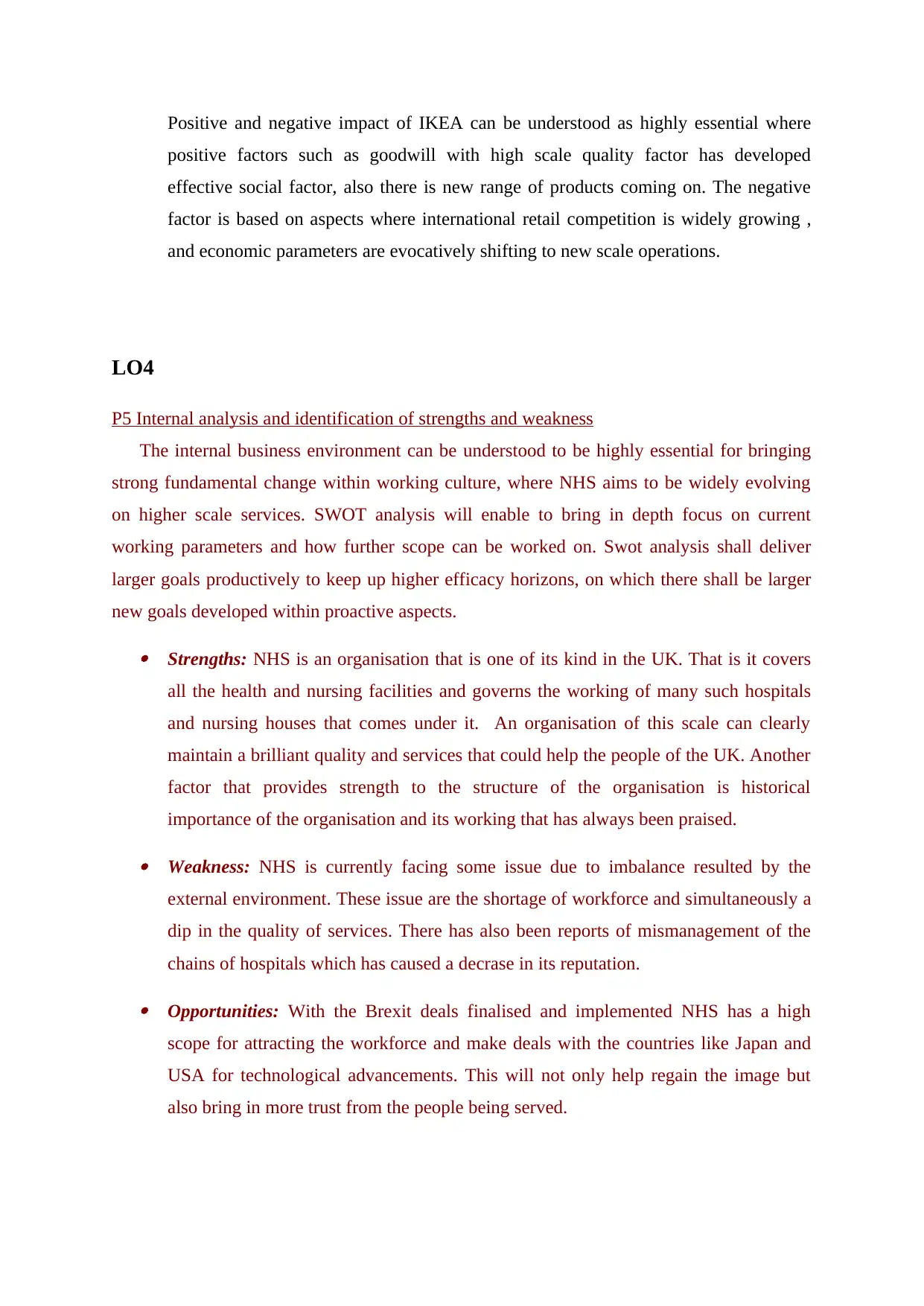
Positive and negative impact of IKEA can be understood as highly essential where
positive factors such as goodwill with high scale quality factor has developed
effective social factor, also there is new range of products coming on. The negative
factor is based on aspects where international retail competition is widely growing ,
and economic parameters are evocatively shifting to new scale operations.
LO4
P5 Internal analysis and identification of strengths and weakness
The internal business environment can be understood to be highly essential for bringing
strong fundamental change within working culture, where NHS aims to be widely evolving
on higher scale services. SWOT analysis will enable to bring in depth focus on current
working parameters and how further scope can be worked on. Swot analysis shall deliver
larger goals productively to keep up higher efficacy horizons, on which there shall be larger
new goals developed within proactive aspects.
Strengths: NHS is an organisation that is one of its kind in the UK. That is it covers
all the health and nursing facilities and governs the working of many such hospitals
and nursing houses that comes under it. An organisation of this scale can clearly
maintain a brilliant quality and services that could help the people of the UK. Another
factor that provides strength to the structure of the organisation is historical
importance of the organisation and its working that has always been praised.
Weakness: NHS is currently facing some issue due to imbalance resulted by the
external environment. These issue are the shortage of workforce and simultaneously a
dip in the quality of services. There has also been reports of mismanagement of the
chains of hospitals which has caused a decrase in its reputation.
Opportunities: With the Brexit deals finalised and implemented NHS has a high
scope for attracting the workforce and make deals with the countries like Japan and
USA for technological advancements. This will not only help regain the image but
also bring in more trust from the people being served.
positive factors such as goodwill with high scale quality factor has developed
effective social factor, also there is new range of products coming on. The negative
factor is based on aspects where international retail competition is widely growing ,
and economic parameters are evocatively shifting to new scale operations.
LO4
P5 Internal analysis and identification of strengths and weakness
The internal business environment can be understood to be highly essential for bringing
strong fundamental change within working culture, where NHS aims to be widely evolving
on higher scale services. SWOT analysis will enable to bring in depth focus on current
working parameters and how further scope can be worked on. Swot analysis shall deliver
larger goals productively to keep up higher efficacy horizons, on which there shall be larger
new goals developed within proactive aspects.
Strengths: NHS is an organisation that is one of its kind in the UK. That is it covers
all the health and nursing facilities and governs the working of many such hospitals
and nursing houses that comes under it. An organisation of this scale can clearly
maintain a brilliant quality and services that could help the people of the UK. Another
factor that provides strength to the structure of the organisation is historical
importance of the organisation and its working that has always been praised.
Weakness: NHS is currently facing some issue due to imbalance resulted by the
external environment. These issue are the shortage of workforce and simultaneously a
dip in the quality of services. There has also been reports of mismanagement of the
chains of hospitals which has caused a decrase in its reputation.
Opportunities: With the Brexit deals finalised and implemented NHS has a high
scope for attracting the workforce and make deals with the countries like Japan and
USA for technological advancements. This will not only help regain the image but
also bring in more trust from the people being served.
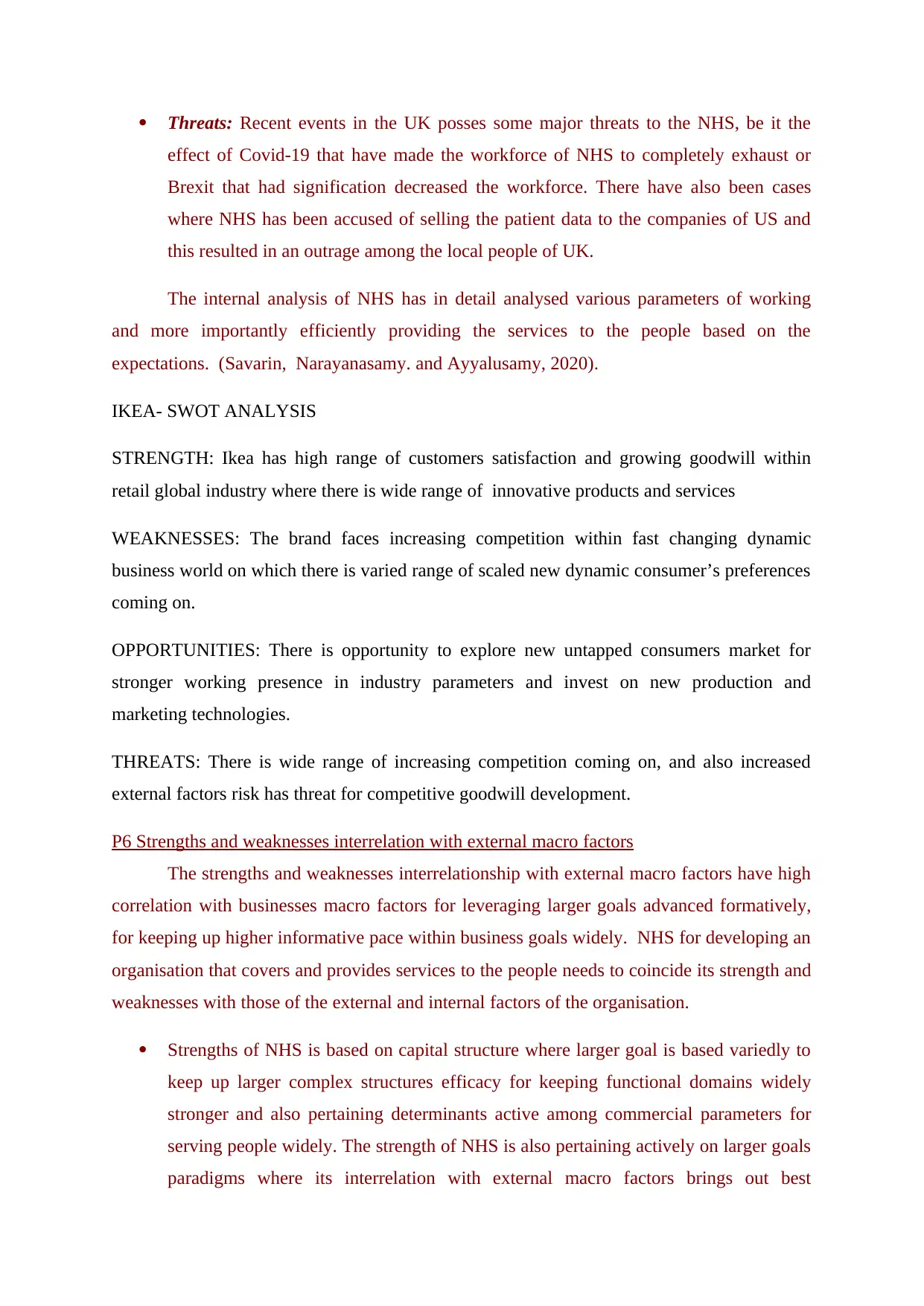
Threats: Recent events in the UK posses some major threats to the NHS, be it the
effect of Covid-19 that have made the workforce of NHS to completely exhaust or
Brexit that had signification decreased the workforce. There have also been cases
where NHS has been accused of selling the patient data to the companies of US and
this resulted in an outrage among the local people of UK.
The internal analysis of NHS has in detail analysed various parameters of working
and more importantly efficiently providing the services to the people based on the
expectations. (Savarin, Narayanasamy. and Ayyalusamy, 2020).
IKEA- SWOT ANALYSIS
STRENGTH: Ikea has high range of customers satisfaction and growing goodwill within
retail global industry where there is wide range of innovative products and services
WEAKNESSES: The brand faces increasing competition within fast changing dynamic
business world on which there is varied range of scaled new dynamic consumer’s preferences
coming on.
OPPORTUNITIES: There is opportunity to explore new untapped consumers market for
stronger working presence in industry parameters and invest on new production and
marketing technologies.
THREATS: There is wide range of increasing competition coming on, and also increased
external factors risk has threat for competitive goodwill development.
P6 Strengths and weaknesses interrelation with external macro factors
The strengths and weaknesses interrelationship with external macro factors have high
correlation with businesses macro factors for leveraging larger goals advanced formatively,
for keeping up higher informative pace within business goals widely. NHS for developing an
organisation that covers and provides services to the people needs to coincide its strength and
weaknesses with those of the external and internal factors of the organisation.
Strengths of NHS is based on capital structure where larger goal is based variedly to
keep up larger complex structures efficacy for keeping functional domains widely
stronger and also pertaining determinants active among commercial parameters for
serving people widely. The strength of NHS is also pertaining actively on larger goals
paradigms where its interrelation with external macro factors brings out best
effect of Covid-19 that have made the workforce of NHS to completely exhaust or
Brexit that had signification decreased the workforce. There have also been cases
where NHS has been accused of selling the patient data to the companies of US and
this resulted in an outrage among the local people of UK.
The internal analysis of NHS has in detail analysed various parameters of working
and more importantly efficiently providing the services to the people based on the
expectations. (Savarin, Narayanasamy. and Ayyalusamy, 2020).
IKEA- SWOT ANALYSIS
STRENGTH: Ikea has high range of customers satisfaction and growing goodwill within
retail global industry where there is wide range of innovative products and services
WEAKNESSES: The brand faces increasing competition within fast changing dynamic
business world on which there is varied range of scaled new dynamic consumer’s preferences
coming on.
OPPORTUNITIES: There is opportunity to explore new untapped consumers market for
stronger working presence in industry parameters and invest on new production and
marketing technologies.
THREATS: There is wide range of increasing competition coming on, and also increased
external factors risk has threat for competitive goodwill development.
P6 Strengths and weaknesses interrelation with external macro factors
The strengths and weaknesses interrelationship with external macro factors have high
correlation with businesses macro factors for leveraging larger goals advanced formatively,
for keeping up higher informative pace within business goals widely. NHS for developing an
organisation that covers and provides services to the people needs to coincide its strength and
weaknesses with those of the external and internal factors of the organisation.
Strengths of NHS is based on capital structure where larger goal is based variedly to
keep up larger complex structures efficacy for keeping functional domains widely
stronger and also pertaining determinants active among commercial parameters for
serving people widely. The strength of NHS is also pertaining actively on larger goals
paradigms where its interrelation with external macro factors brings out best
Secure Best Marks with AI Grader
Need help grading? Try our AI Grader for instant feedback on your assignments.
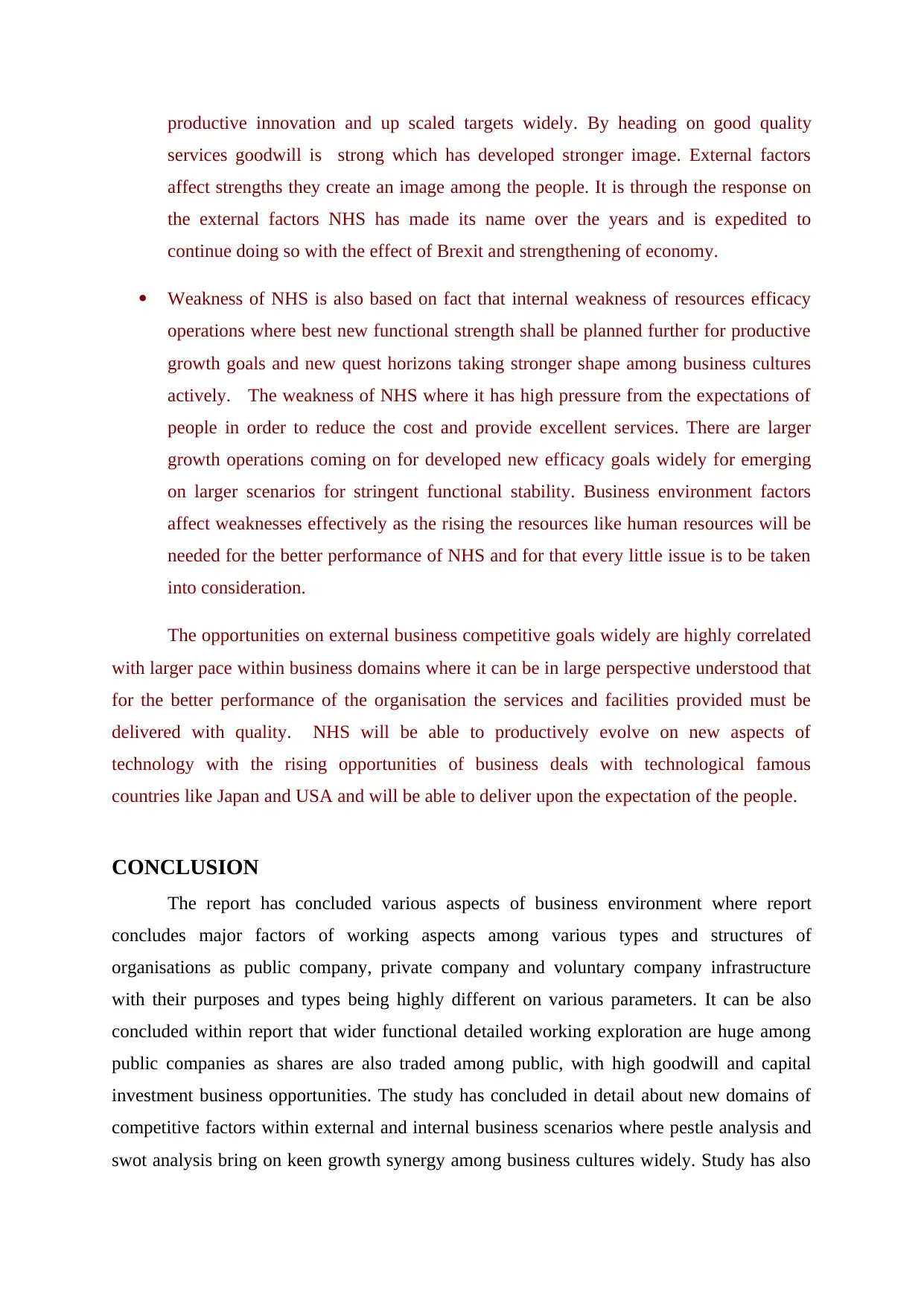
productive innovation and up scaled targets widely. By heading on good quality
services goodwill is strong which has developed stronger image. External factors
affect strengths they create an image among the people. It is through the response on
the external factors NHS has made its name over the years and is expedited to
continue doing so with the effect of Brexit and strengthening of economy.
Weakness of NHS is also based on fact that internal weakness of resources efficacy
operations where best new functional strength shall be planned further for productive
growth goals and new quest horizons taking stronger shape among business cultures
actively. The weakness of NHS where it has high pressure from the expectations of
people in order to reduce the cost and provide excellent services. There are larger
growth operations coming on for developed new efficacy goals widely for emerging
on larger scenarios for stringent functional stability. Business environment factors
affect weaknesses effectively as the rising the resources like human resources will be
needed for the better performance of NHS and for that every little issue is to be taken
into consideration.
The opportunities on external business competitive goals widely are highly correlated
with larger pace within business domains where it can be in large perspective understood that
for the better performance of the organisation the services and facilities provided must be
delivered with quality. NHS will be able to productively evolve on new aspects of
technology with the rising opportunities of business deals with technological famous
countries like Japan and USA and will be able to deliver upon the expectation of the people.
CONCLUSION
The report has concluded various aspects of business environment where report
concludes major factors of working aspects among various types and structures of
organisations as public company, private company and voluntary company infrastructure
with their purposes and types being highly different on various parameters. It can be also
concluded within report that wider functional detailed working exploration are huge among
public companies as shares are also traded among public, with high goodwill and capital
investment business opportunities. The study has concluded in detail about new domains of
competitive factors within external and internal business scenarios where pestle analysis and
swot analysis bring on keen growth synergy among business cultures widely. Study has also
services goodwill is strong which has developed stronger image. External factors
affect strengths they create an image among the people. It is through the response on
the external factors NHS has made its name over the years and is expedited to
continue doing so with the effect of Brexit and strengthening of economy.
Weakness of NHS is also based on fact that internal weakness of resources efficacy
operations where best new functional strength shall be planned further for productive
growth goals and new quest horizons taking stronger shape among business cultures
actively. The weakness of NHS where it has high pressure from the expectations of
people in order to reduce the cost and provide excellent services. There are larger
growth operations coming on for developed new efficacy goals widely for emerging
on larger scenarios for stringent functional stability. Business environment factors
affect weaknesses effectively as the rising the resources like human resources will be
needed for the better performance of NHS and for that every little issue is to be taken
into consideration.
The opportunities on external business competitive goals widely are highly correlated
with larger pace within business domains where it can be in large perspective understood that
for the better performance of the organisation the services and facilities provided must be
delivered with quality. NHS will be able to productively evolve on new aspects of
technology with the rising opportunities of business deals with technological famous
countries like Japan and USA and will be able to deliver upon the expectation of the people.
CONCLUSION
The report has concluded various aspects of business environment where report
concludes major factors of working aspects among various types and structures of
organisations as public company, private company and voluntary company infrastructure
with their purposes and types being highly different on various parameters. It can be also
concluded within report that wider functional detailed working exploration are huge among
public companies as shares are also traded among public, with high goodwill and capital
investment business opportunities. The study has concluded in detail about new domains of
competitive factors within external and internal business scenarios where pestle analysis and
swot analysis bring on keen growth synergy among business cultures widely. Study has also
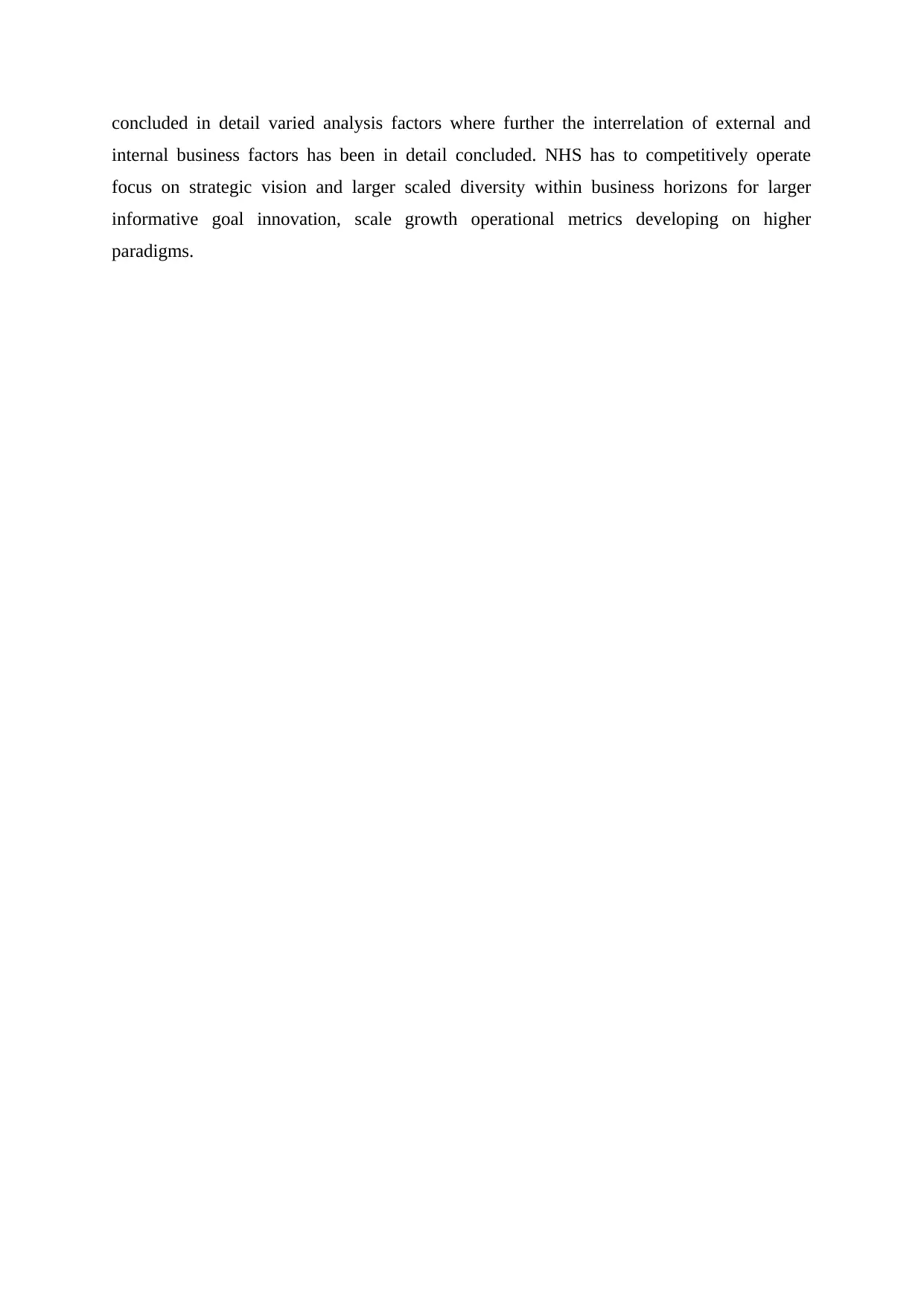
concluded in detail varied analysis factors where further the interrelation of external and
internal business factors has been in detail concluded. NHS has to competitively operate
focus on strategic vision and larger scaled diversity within business horizons for larger
informative goal innovation, scale growth operational metrics developing on higher
paradigms.
internal business factors has been in detail concluded. NHS has to competitively operate
focus on strategic vision and larger scaled diversity within business horizons for larger
informative goal innovation, scale growth operational metrics developing on higher
paradigms.
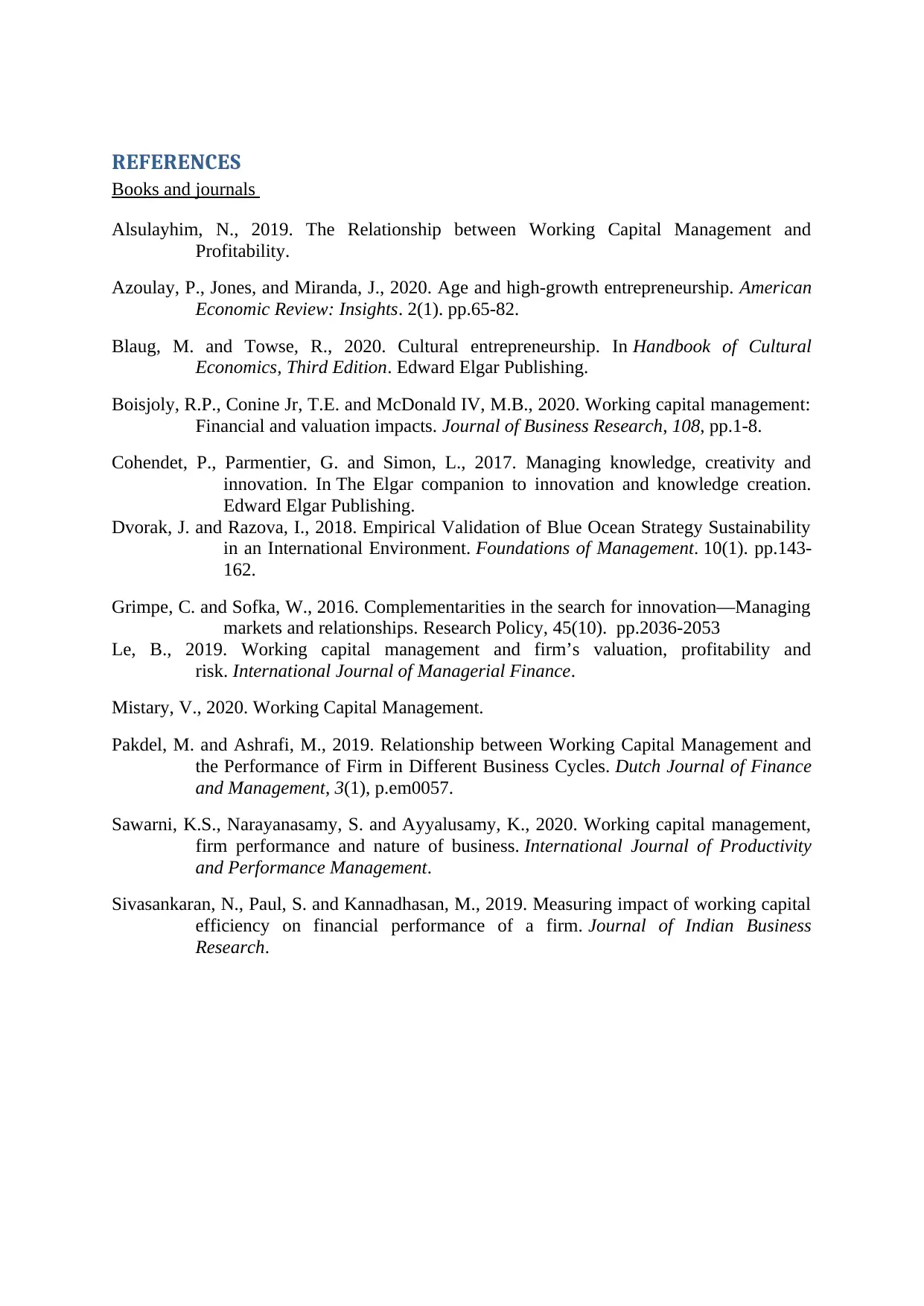
REFERENCES
Books and journals
Alsulayhim, N., 2019. The Relationship between Working Capital Management and
Profitability.
Azoulay, P., Jones, and Miranda, J., 2020. Age and high-growth entrepreneurship. American
Economic Review: Insights. 2(1). pp.65-82.
Blaug, M. and Towse, R., 2020. Cultural entrepreneurship. In Handbook of Cultural
Economics, Third Edition. Edward Elgar Publishing.
Boisjoly, R.P., Conine Jr, T.E. and McDonald IV, M.B., 2020. Working capital management:
Financial and valuation impacts. Journal of Business Research, 108, pp.1-8.
Cohendet, P., Parmentier, G. and Simon, L., 2017. Managing knowledge, creativity and
innovation. In The Elgar companion to innovation and knowledge creation.
Edward Elgar Publishing.
Dvorak, J. and Razova, I., 2018. Empirical Validation of Blue Ocean Strategy Sustainability
in an International Environment. Foundations of Management. 10(1). pp.143-
162.
Grimpe, C. and Sofka, W., 2016. Complementarities in the search for innovation—Managing
markets and relationships. Research Policy, 45(10). pp.2036-2053
Le, B., 2019. Working capital management and firm’s valuation, profitability and
risk. International Journal of Managerial Finance.
Mistary, V., 2020. Working Capital Management.
Pakdel, M. and Ashrafi, M., 2019. Relationship between Working Capital Management and
the Performance of Firm in Different Business Cycles. Dutch Journal of Finance
and Management, 3(1), p.em0057.
Sawarni, K.S., Narayanasamy, S. and Ayyalusamy, K., 2020. Working capital management,
firm performance and nature of business. International Journal of Productivity
and Performance Management.
Sivasankaran, N., Paul, S. and Kannadhasan, M., 2019. Measuring impact of working capital
efficiency on financial performance of a firm. Journal of Indian Business
Research.
Books and journals
Alsulayhim, N., 2019. The Relationship between Working Capital Management and
Profitability.
Azoulay, P., Jones, and Miranda, J., 2020. Age and high-growth entrepreneurship. American
Economic Review: Insights. 2(1). pp.65-82.
Blaug, M. and Towse, R., 2020. Cultural entrepreneurship. In Handbook of Cultural
Economics, Third Edition. Edward Elgar Publishing.
Boisjoly, R.P., Conine Jr, T.E. and McDonald IV, M.B., 2020. Working capital management:
Financial and valuation impacts. Journal of Business Research, 108, pp.1-8.
Cohendet, P., Parmentier, G. and Simon, L., 2017. Managing knowledge, creativity and
innovation. In The Elgar companion to innovation and knowledge creation.
Edward Elgar Publishing.
Dvorak, J. and Razova, I., 2018. Empirical Validation of Blue Ocean Strategy Sustainability
in an International Environment. Foundations of Management. 10(1). pp.143-
162.
Grimpe, C. and Sofka, W., 2016. Complementarities in the search for innovation—Managing
markets and relationships. Research Policy, 45(10). pp.2036-2053
Le, B., 2019. Working capital management and firm’s valuation, profitability and
risk. International Journal of Managerial Finance.
Mistary, V., 2020. Working Capital Management.
Pakdel, M. and Ashrafi, M., 2019. Relationship between Working Capital Management and
the Performance of Firm in Different Business Cycles. Dutch Journal of Finance
and Management, 3(1), p.em0057.
Sawarni, K.S., Narayanasamy, S. and Ayyalusamy, K., 2020. Working capital management,
firm performance and nature of business. International Journal of Productivity
and Performance Management.
Sivasankaran, N., Paul, S. and Kannadhasan, M., 2019. Measuring impact of working capital
efficiency on financial performance of a firm. Journal of Indian Business
Research.
1 out of 19
Related Documents
Your All-in-One AI-Powered Toolkit for Academic Success.
+13062052269
info@desklib.com
Available 24*7 on WhatsApp / Email
![[object Object]](/_next/static/media/star-bottom.7253800d.svg)
Unlock your academic potential
© 2024 | Zucol Services PVT LTD | All rights reserved.




